












Dear Reader,
Writing this letter means we have completed our inaugural issue at Strike Los Angeles. I have found myself overcome with an array of emotions as my time with Strike Magazine is now coming to an end. However, I can happily say this endeavor has undoubtedly been one of the most enriching experiences of my life. I am extremely grateful for every single staff member trusting in me to facilitate this issue and lead our branch.
I would like to especially thank my co-founder and creative director, Lily Boses. This magazine would not have been possible without her creative vision and relentless drive. I cannot count the number of nights that Lily and I brainstormed and worked on this magazine until the early hours of the morning. When things got overwhelming and I had moments where I questioned our ability to complete Issue 01, Lily was there to calm my nerves and help me see through my ludicrous panic. Here’s to you, Lily.
Growing up in Nashville, I had been loosely aware of Strike Magazine but had no idea how much soul has been poured into the name “Strike.” One day in January of 2023, I found myself browsing the Strike website, looking at the content produced by the various branches, when I realized that not only was there no branch in Los Angeles, but there was not a single branch on the West Coast. I almost immediately began working on a pitch to send to Emma Oleck, Cheif Executive Advisor at Srike HQ. To my surprise, she responded to my message, and we scheduled a meeting to discuss the possibility of adding a new branch to the Strike family. These conversations continued, and after multiple in-depth meetings and interview screening, Emma trusted Lily and me to establish the inaugural West Coast branch. Thus, Strike L.A. was born.
From the beginning, we knew that issue 01 of Strike Los Angeles had to pay homage to the city it represents. With that, the theme for this issue is simply “Los Angeles.” In the creation of this theme, we took immense inspiration from the significant impact this city has had on so many different facets, specifically pop culture. Each concept within this magazine has been greatly influenced by a neighborhood of Los Angeles, touching on some of the most notable attributions of that location.
I hope that the hard work, creativity, and passion poured into this issue is represented in the pages you are about to see. Each copy of this magazine is a physical manifestation of the talent our team obtains. Thank you for your part in this issue.
With warmest regards and appreciation, Strike Out,
Ethan Cox Editor-in-ChiefAs someone born and raised in Southern California, my love for L.A. runs deep. This city has shaped me, and I wanted our pages to reflect its true soul. I am beyond blessed and honored to be in the position to write this letter. With that, I want to tell you about the past, present, and outcome of this issue.
Past:
When Ethan told me what Strike was and that he wanted to start an LA chapter, I was immediately on board. I had just returned from abroad, having completed my film minor, and was in dire need of something new and creative. In all honesty, I had no clue how much constant effort and time this would take. However, I did know I was surrounded by very talented people who lacked an outlet to turn their potential into reality. I wanted to offer a space for unrestricted creativity, where anyone could explore their interests without limitations.
Present:
After the first meeting as the creative director, I immediately felt a wave of fear and regret. I had no clue what I was doing and did not want the new team of over 40 excited students to rely on me. Ethan calmed me down, and I can proudly say that was the only (big) breakdown I had over the past year of being a part of Strike. In that moment, I felt immensely seen and supported by Ethan, which launched my confidence in making this the best issue I possibly could. There have been countless laughs, pushing through my tiresome, proud moments, frustrating times, and everything in between that I have shared with Ethan to make this issue come to life. It’s been an extraordinary experience. And that’s simply because I had the best partner in crime. Ethan, thank you for being you.
Outcome:
I made it my goal to delve beyond the surface-level glamour often portrayed in the media. I wholeheartedly believe the city of dreams holds true to its name; yet, it possesses an immense ability to be simultaneously gritty and beautiful, sprawling yet intimate. Our shoots across such iconic locations of L.A. were not just about capturing images but about honoring this city’s multifaceted past and present story.
A huge thank you to everyone involved — from our staff and models to friends who helped week after week. Though Strike L.A. would not have been possible without the hard work and dedication of every single one of its members, I’d like to especially thank the following:
Thank you, Natalie, for not only being by my side throughout this journey but also for sharing your amazing creative vision that has inspired me beyond belief. Miranda, you exemplify exactly what this magazine was made for, and I have adored watching your progress. Christian, your constant reassurance and positive energy have brought lightness to each shoot day. Kate G, your faith and dedication to this branch from the very beginning has been foundational for its success. Gehna, for making every model look and feel beautiful. Nicole H, for being someone who truly steps up to the plate when needed. Mayah, for your constant encouragement and excitement, filling in the cracks wherever needed.
I hope you find as much joy and inspiration in these pages as I have in creating them. To anyone who picks up this magazine, I wish you good health, fulfillment, and happiness.
With gratitude,
Lily Boses Creative Director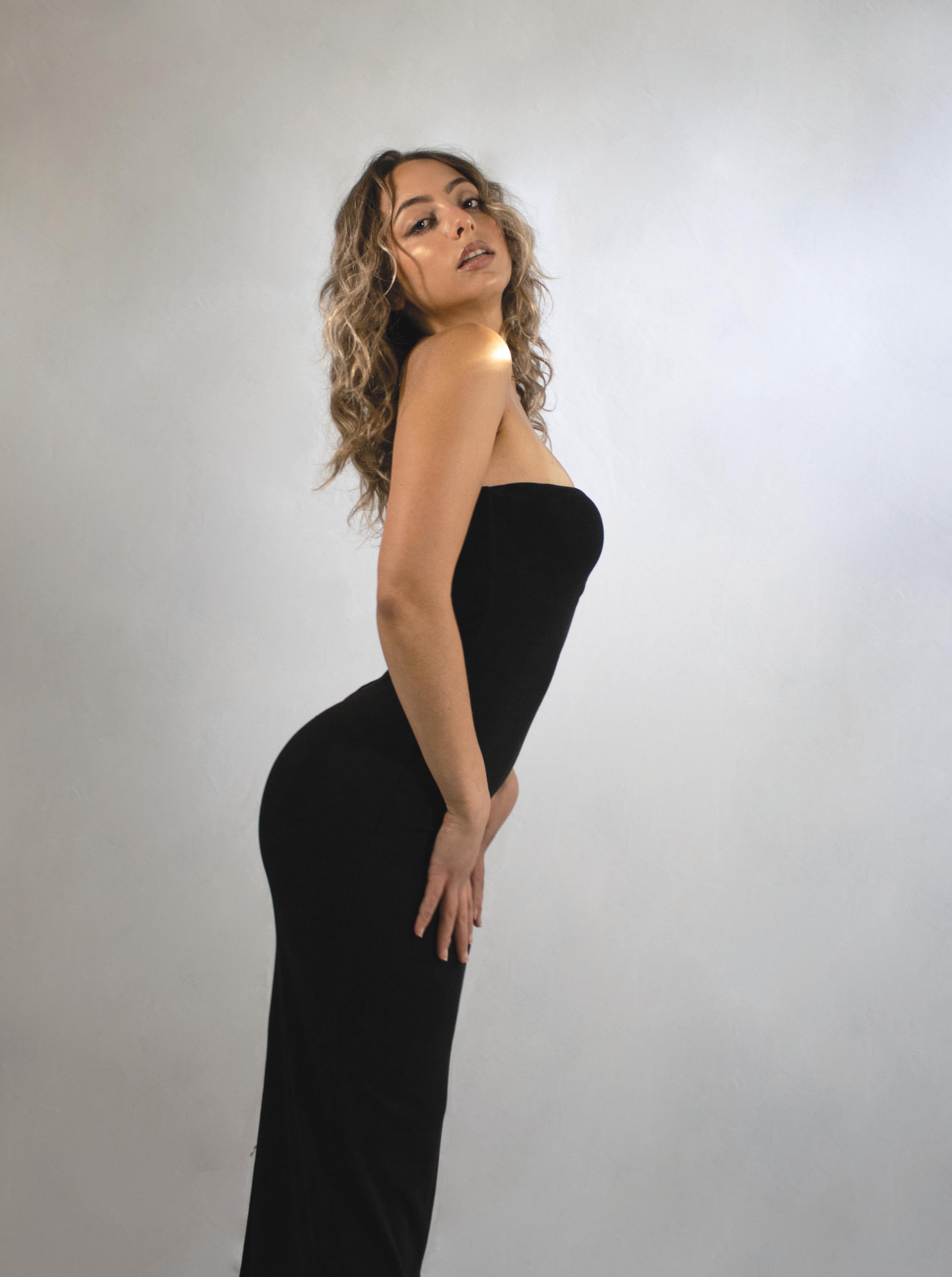



Directors Ethan Cox, Lily Boses Design Nicole Han, Nicole Dressel Photography Chrissy Saenz, Miranda Cardenas Beauty Gehna Chugani Videographer Natalie Lopez Production Gabriella Gilchriese Stylist Alexis Lee, Ahu Alembegui Models Tanner Agpoon-Steinbock, Megan Houlihan, Joey Kula Writer Riley Powers


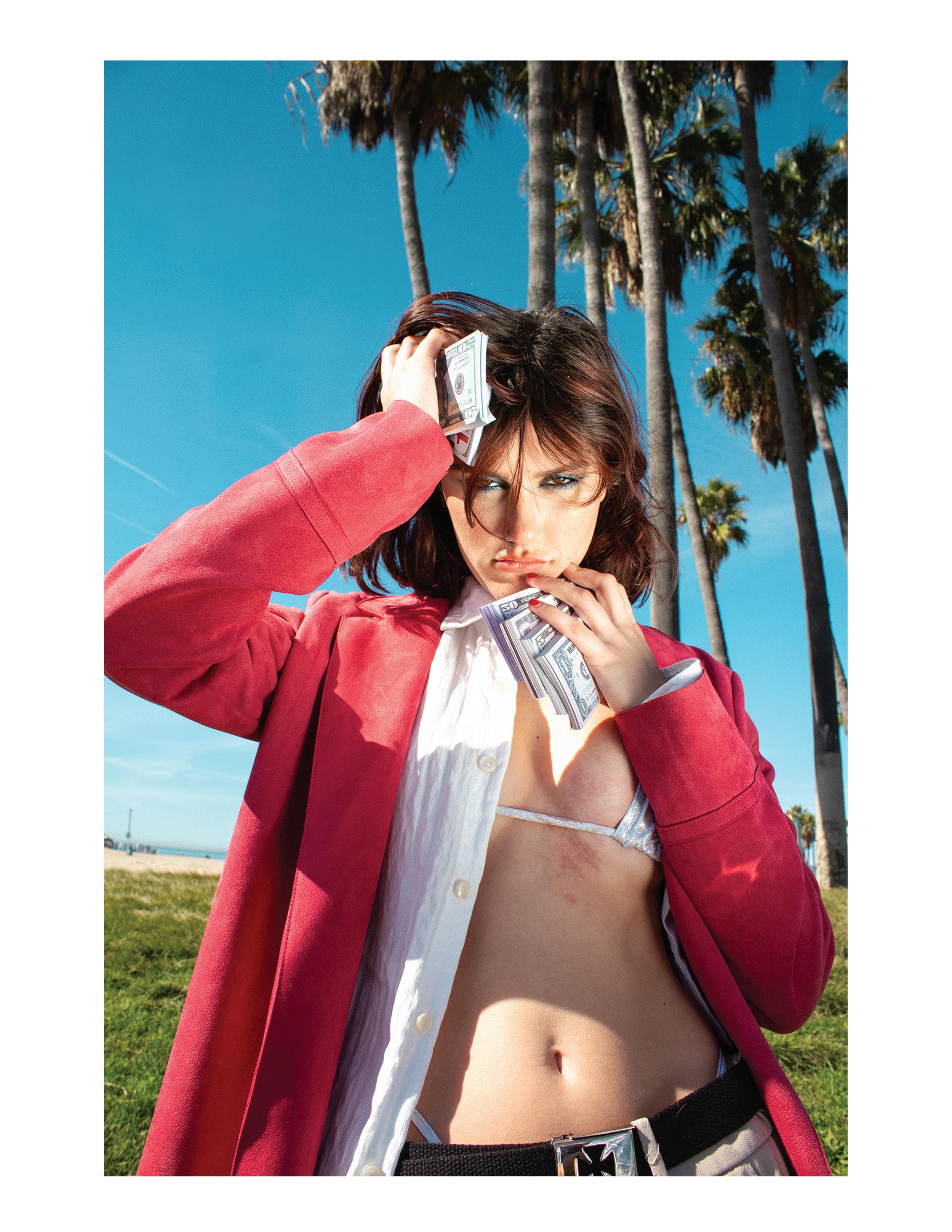
Skaters, street performers, tourists, graffiti artists, and practicing and retired hippies line the all encompassing boardwalk that has more than a century of footracks underneath it’s belt. Envisioned and executed by the infamous Abbot Kinney in 1905, Venice is a labor of love born from the mind of a man set on replicating the allure and culture associated with Venice, Italy. Kinney partially succeeded in his mission with the creation of the canals and the extensive art community born in the area, but what truly came from the creation of Venice was something irreplicable. Through historical accounts, it is known to us that the area where modern day Venice lies was originally inhabited by Native Shoshone and Tongva Gabrieleño societies who utilized this land by the water to fish and hunt. Spanish colonization of the land eventually occurred and in 1839 the Rancho La Ballona land grant was given to two pairs of brothers who had been occupants of the region for quite some time; Ygnacio and Augustin Machado and Felipe and Tomas Talamantes. This land grant encompassed many places we know and adore today in Southern California, such as Culver City, Mar Vista, the Ballona Wetlands, and Loyola Marymount Universities backyard beach, Playa Del Rey.
Abbot Kinney, having amassed a considerable fortune in the tobacco industry with his brother, journeyed westward in the late 1800s first arriving in San Francisco. After settling in the San Gabriel Valley and establishing the San Gabriel Timberland Reserve with John Muir, Kinney’s wife, Margaret, was ready for a change of scenery and urged a move to Santa Monica. There, Kinney founded the Santa Monica Improvement Company and a tennis club. His partnership with Francis Ryan was instrumental in the creation of Venice, marked by acquiring the Pacific Ocean Casino and developing a boardwalk, golf course, pier, and racetrack on a 2-mile strip of land. Following Ryan’s death and an ill fated coin flip, Kinney turned the marshland and lagoons of the area into canals, inspired by his travels in Europe, particularly Venice, Italy, realizing his vision for a successful new city.
The Venice we know and adore today is a cultural center, a hub for the eclectic and the absurd. A destination where the fire of counterculture movements were able to have life breathed into them. Whether it be at the skatepark, the boardwalk, or Abbot Kinney Boulevard, this small but mighty city is littered with people from all different backgrounds and circumstances. It’s what makes Venice, Venice. There’s no surprise in learning that it is the second most popular spot to visit in California after the staple Disneyland.
A chance encounter between Jim Morrison and Ray Manzarek on the beaches of Venice led to the creation of one of the most famous rock bands of all time, The Doors. Both members of the band had attended the UCLA School of Film and Television and recognized one another. Through swapping poetry and other creative works on the beach, they came to a shared realization they should give it a shot by forming a band; the rest is history.
Known for her melancholic and alternative sound, paired with a once in a lifetime voice, Lana Del Rey effortlessly creates a dreamy image of the city on her longest running single to date, “Venice Bitch.” The title of the song is a play on the words “Venice Beach,” a location where Del Rey frequents and has drawn inspiration from. In 2018, a mural created by Jonas Never was painted on the side of the beloved Ellison Hotel near the boardwalk, with lyrics from her breakout single “Video Games” accompanying the image. Del Rey is viewed as a cultural icon, a woman noted for her Americana themes and vintage look and sound. It’s arguable her that image draws direct inspiration from the things we credit Venice with invigorating.
A mere twenty years after becoming the first state to legalize medical marijuana usage, California took this a step further in legalizing marijuana for recreational use in 2016. While visiting the Venice Boardwalk these days, it’s almost impossible to pass a shop that isn’t selling some sort of “weed” memorabilia. Whether it be as simple as an “I Heart Weed” t-shirt or as complex as a bong with so many nooks and crannies it’s easy to become lost in its details. When we think of Venice, it’s difficult to not have a mental image of the bold and bright Venice sign located at Pacific and Windward avenues. This sign, now viewed as a landmark, has functioned as a popular culture fixture and entry point to the boardwalk for many years now. The sign has changed its lighting, coinciding with different holidays for quite some time now. April 20th, or 4/20, a relatively new holiday celebrating all of the pot lovers around the country, has found its bearings within this sign, where pot leaves can be observed with a green hue on the holiday.
The dreamy spirit of Venice runs deep. Built from soggy grounds up into the vibrant epicenter of culture we know it for today, this place will forever be celebrated for its eccentricness and character.
Much of Southern California is known for its plethora of beaches where the crashing waves of the Pacific draw in surfers from near and far. Venice beach has its fair share of surfers as well, but this neighborhood is even more well known for its skateboarding culture, due to the creation of the Venice Skate Park in 2009. Many surfers moonlight as skaters as well, but it’s difficult to argue against the idea that over the years Venice has become the home of skateboarding on the West Coast. A person could even go as far to say that Venice is the home of skating in general, as we see people zooming down the boardwalk on their roller skates at all hours of the day.
Hell, everyone saw Barbie this past summer, mesmerized by Marbot Robbie and Ryan Gosling grooving as one down the iconic strip. There is a rich history concerning skate culture in the Venice Beach and Santa Monica areas that dates all the way back to the 1970’s. The area even has a particular name for it; “Dogtown.” The phenomenon started when surfers in the area gradually began to try their luck at skateboarding, and from there the popularity continued to flourish up until what we see today; hundreds of skaters, each from different backgrounds and skill levels, coming together over a shared passion that excites them. It’s community building at its finest and it underscores just how special Venice Beach truly is.
Another group that is unique to Venice and Venice alone is the alternative, countercultured and funk fueled art community. You simply cannot visit Venice without witnessing the Venice Art Walls (or Venice Graffiti Walls) that are scattered around the beach. Seasoned and beginner artists make their mark on these walls hoping their pieces resonate with anyone who glares at them. There are different murals all around the neighborhood, an example being the “Touch of Venice Mural” located on Windward Avenue. Another prominent member of the art community is the Mosaic Tile House with its signature rainbow hue and thought provoking design located on Palms Boulevard. These are just a few of the alluring art attractions that define Venice Beach.
The West Coast branch of beat poets and artists also found their home in Venice in the 1950’s. The beat poets could best be described as a literary counterculture movement created by a group of people with the goal of their work being to push back against conformity and conventional writing styles. Also known as the Beatniks, this younger group of writers sought to push back against the ideals associated with suburbia and consumerism. They came to be post WWII and had a hand in influencing American politics and culture through their published works. A monument commemorating these writers is located along the ocean front walk of Venice Beach.
The dreamy spirit of Venice runs deep. Built from soggy grounds up into the vibrant epicenter of culture we know it for today, this place will forever be celebrated for its eccentricness and character. From its inception until today, its abundantly clear Venice has gone through a variety of alterations that have shaped the city for the better. Venice will continue to evolve in the years to come, but its diverse and colorful history will remain interwoven into its streets and canals, forever cherished as a beacon of creativity, resilience, and free spiritedness.
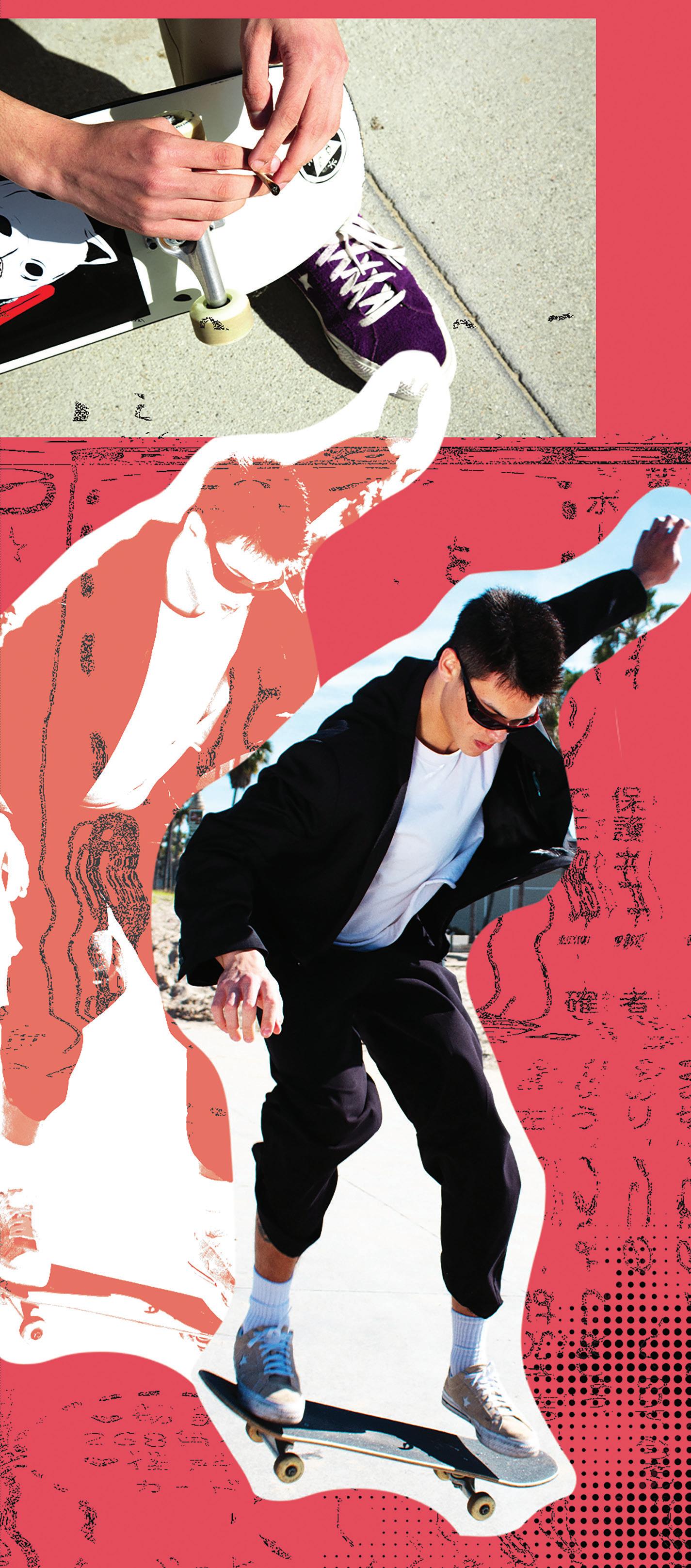

A gateway drug. The devil’s lettuce. The silent executioner of our seemingly impressionable youth. All terms with negative connotations associated with the flowery cannabis plant, also known as marijuana. The moral panic associated with marijuana is somewhat understandable, but is simultaneously extremely outdated. It’s a foreign substance, harvested with the sole intent to be ingested. It made perfect sense that this thought did not bode well with many people, particularly concerned parents. But over the years, research on marijuana has been thoroughly conducted and its scope has only
expanded, becoming prevalent in food products, drinks, vape pens, capsules, oils and so on. Usually smoked or ingested, the viewpoints around marijuana have always been mixed, many people claiming the substance makes a person lazy and unmotivated and poses the threat of getting someone hooked on more serious drugs. On the other hand, in more recent times, cases have been made for marijuana that suggest the drug is relaxing, productivity enhancing, medically and therapeutically useful and in many cases, just a plain good time.
It’s always been interesting how contemporary society views marijuana’s arguable adversary, alcohol. We praise it. We indulge in it multiple times a week. It makes us more sociable, it leads to connection, it allows us to relax, it’s fun! We see advertisements for alcohol everyday, lauding it, judging those who choose to not partake. On the other hand, it has the potential to hinder us, lead to unproductivity, hurt our relationships, and lead to serious health problems. The similarities between both “drugs” is clearly there, yet one takes the brunt of criticism and skepticism.
Luckily, the times are changing, and society has begun to have more varying perspectives when it comes to how we view the substances we partake in recreationally or medicinally. In 1996, California became the first state to legalize marijuana for medical usage and twenty years later legalized the substance for recreational use as well. It’s safe to say the West Coast, California in particular, has always been ahead of the curve. Today, there are twenty four states that have fully legalized marijuana usage, signifying that the stigma around the drug is beginning to fade in many places where it was once vilified.
Growing up in a small and desolate town where marijuana was treated as a capital offense, moving out to Los Angeles was quite the culture shock when I made my first stroll down the boardwalk in Venice Beach. “I heart weed” memorabilia lined the stands of souvenir shops, modern day “hippies” could be spotted at any given point while walking, bright and colorful smoking devices were carefully laid in rows behind glass, and the unmistakable smell of joints being burned was all around in the air. This was new for me and probably just about anyone else who moved to Los Angeles from a place where weed was frowned upon, unaware of just how progressive the state is when it comes to their views on marijuana. It was refreshing.
In a world where a countless amount of people are still serving prison sentences for marijuana related offenses, it felt unfair. According to the Last Prisoner Project, there are over 40,000 people incarcerated for marijuana possession in the United States. This seems to directly contradict the shift in the times we’ve seen firsthand, and is a pressing issue that deserves attention from the highest level of our government.
We even observe an unofficial holiday that celebrates the usage of marijuana. Seasoned weed smokers, sometimes nicknamed “stoners,” and relatively new users of cannabis are able to rejoice and “spark up” on this holiday, underscoring the idea there is a very clear community aspect to using marijuana. It would only make sense that
this holiday was born in the state of California as well. In the 1970’s at San Rafael High School in Northern California, a group of high schoolers who dubbed themselves as “the Waldos” would meet regularly at 4:20pm to smoke together. The group did this routinely and eventually the phenomenon caught wind beyond the halls of their school, reaching audiences globally. This was in part due to the popular band who are synonymous with weed smoking, The Grateful Dead. A member of the waldos, Dave Reddix scored a job as a roadie for bassist Phil Lesh, and eventually flyers were distributed at concerts, advertising for pot lovers to light up at 4:20 pm on April 20th. The rest became history.
On October 1st of 2019, the Cannabis Cafe was opened for business in West Hollywood. A chic and modern eatery where patrons could order savory food while also getting high. This establishment snagged the title of the official first place in California where it was legal to ingest both cannabis and a great meal simultaneously. Multiple businesses similar to this one have popped up all around Los Angeles, ranging from coffee drinks to alcoholic beverages infused with marijuana.
Weed also appears to be great for the economy in California. Recreational marijuana sales have skyrocketed since its legalization, the legal market racking up 4.4 billion in sales in just 3 years. (Marijuana Business Daily). If it wasn’t clear enough, weed has become mainstream on the West Coast, signaling for an end to a stigma that has had long lasting negative effects on many people.
The medical benefits of cannabis have also been reported on extensively. In many cases, cannabidiol (CBD) is extracted from the hemp plant to be utilized medicinally, not the THC compound also found in hemp plants which produces the “high effect” many people desire. Usually distributed in pill, powder, liquid, oil, or dried leaves, medical marijuana can aid in treating a variety of conditions. Some of these include chronic pains, insomnia, nausea, lowering blood pressure, relieving anxiety, reducing inflammation, preventing seizures, and so on.
Marijuana has come a long way in terms of how we view the drug from social, cultural, and political standpoints. There will always be skeptics and those who are indifferent towards the benefits of cannabis, but this is a reality for any sort of drug or smoking product. Changing the narrative around any topic is difficult and oftentimes uncomfortable, but an alteration to how we perceive and view marijuana has been long overdue. In the ever-evolving discourse surrounding cannabis, California has been and will remain a place that paves the way forward, with worthwhile results just on the horizon.
Written by Riley Powers

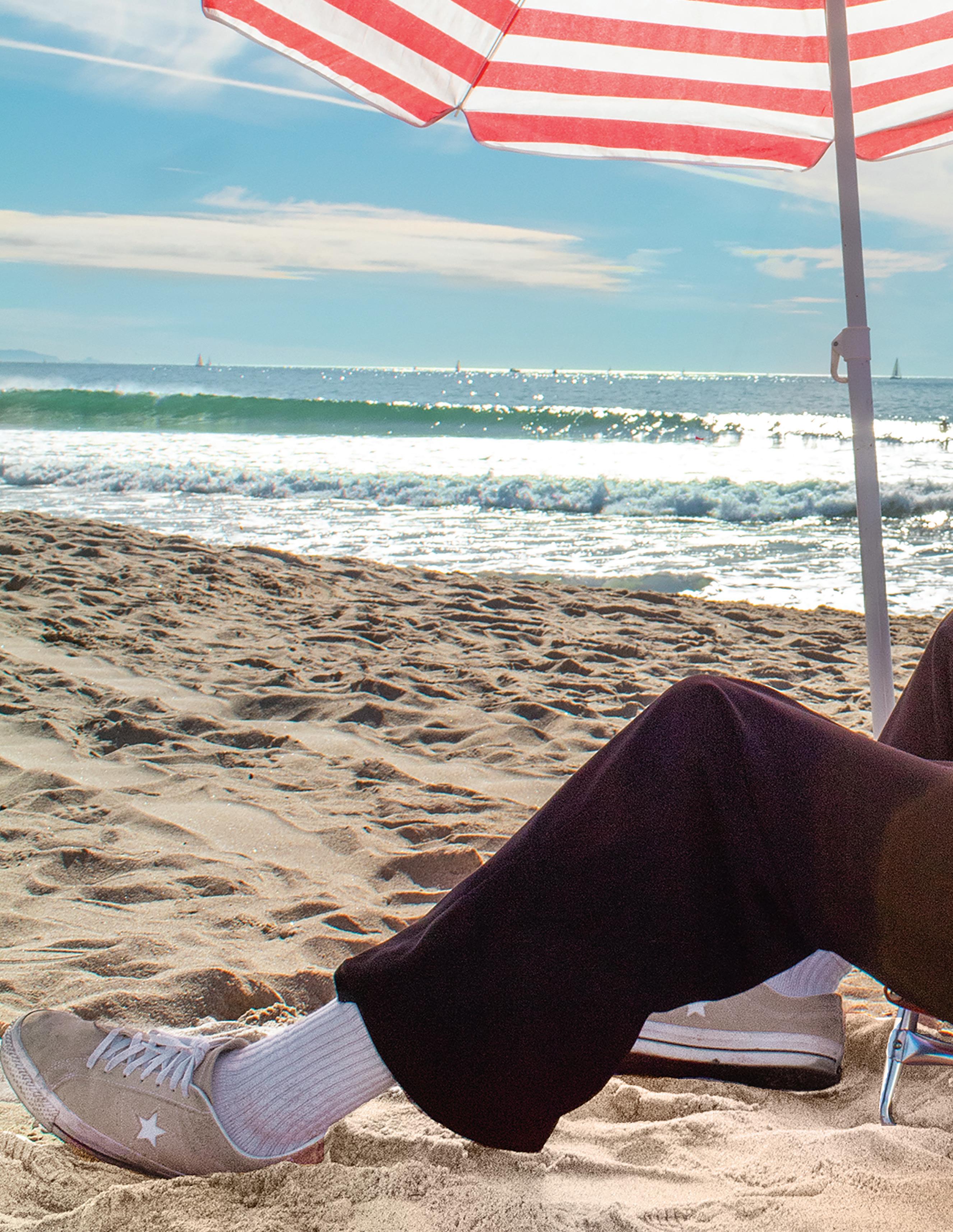
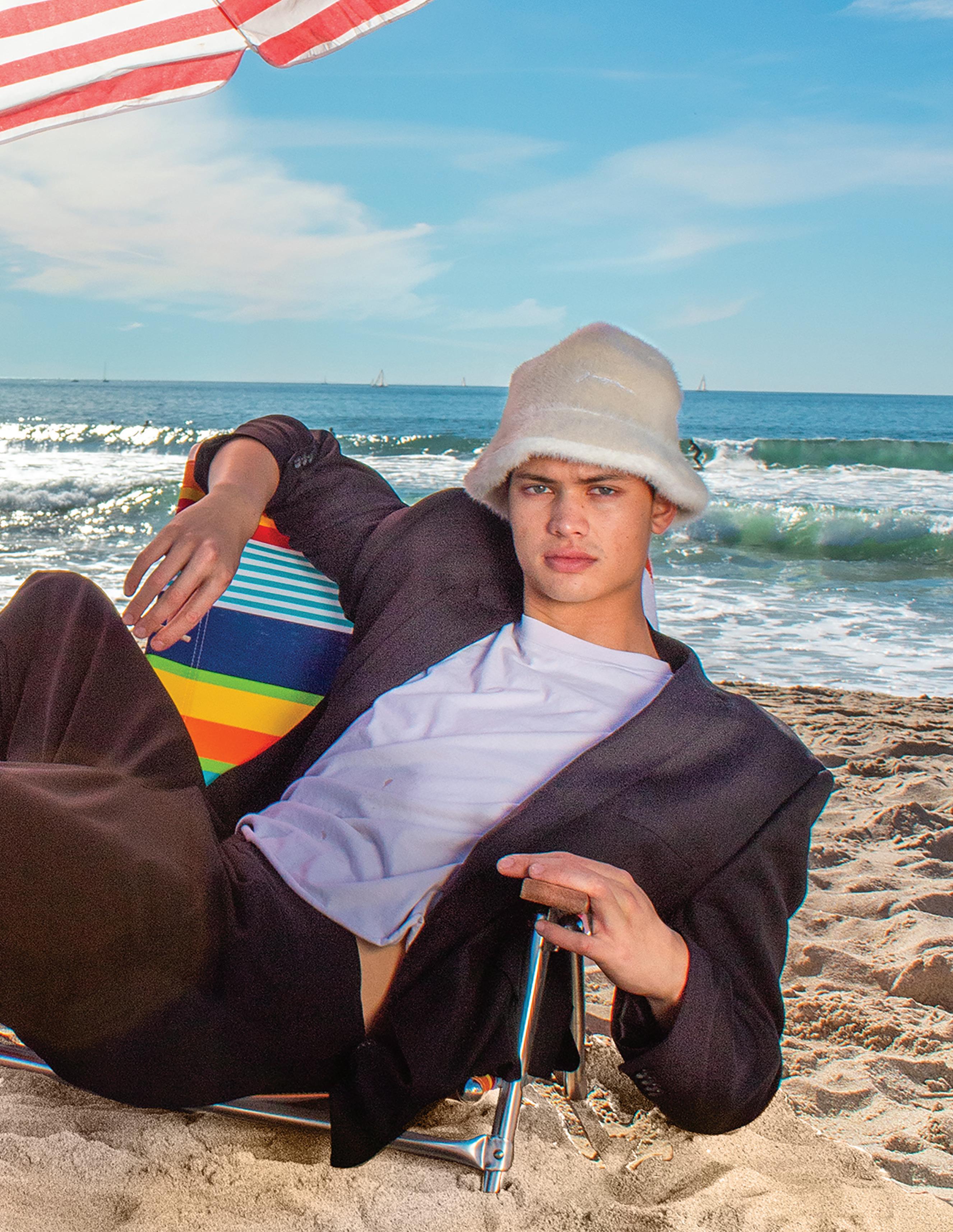

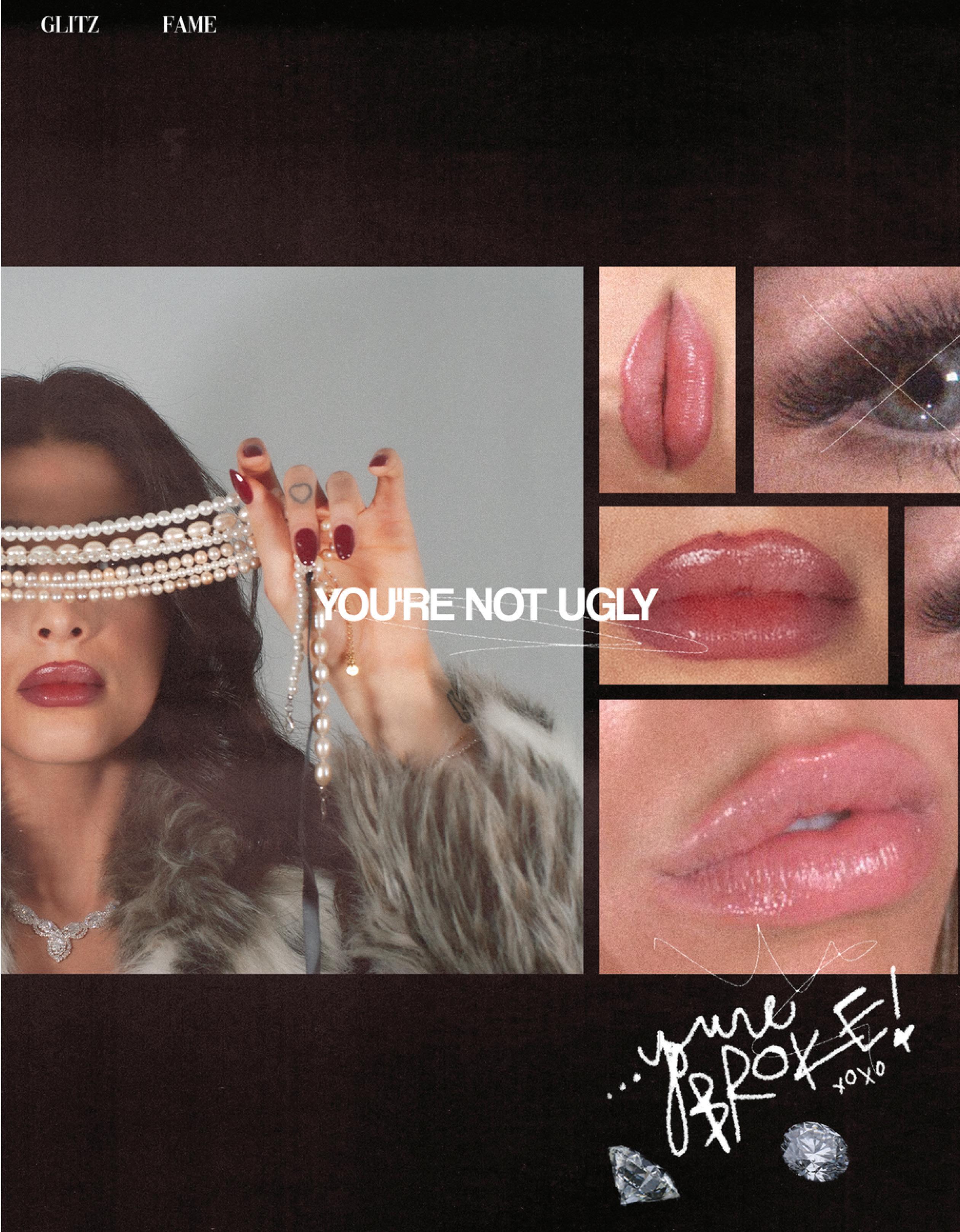

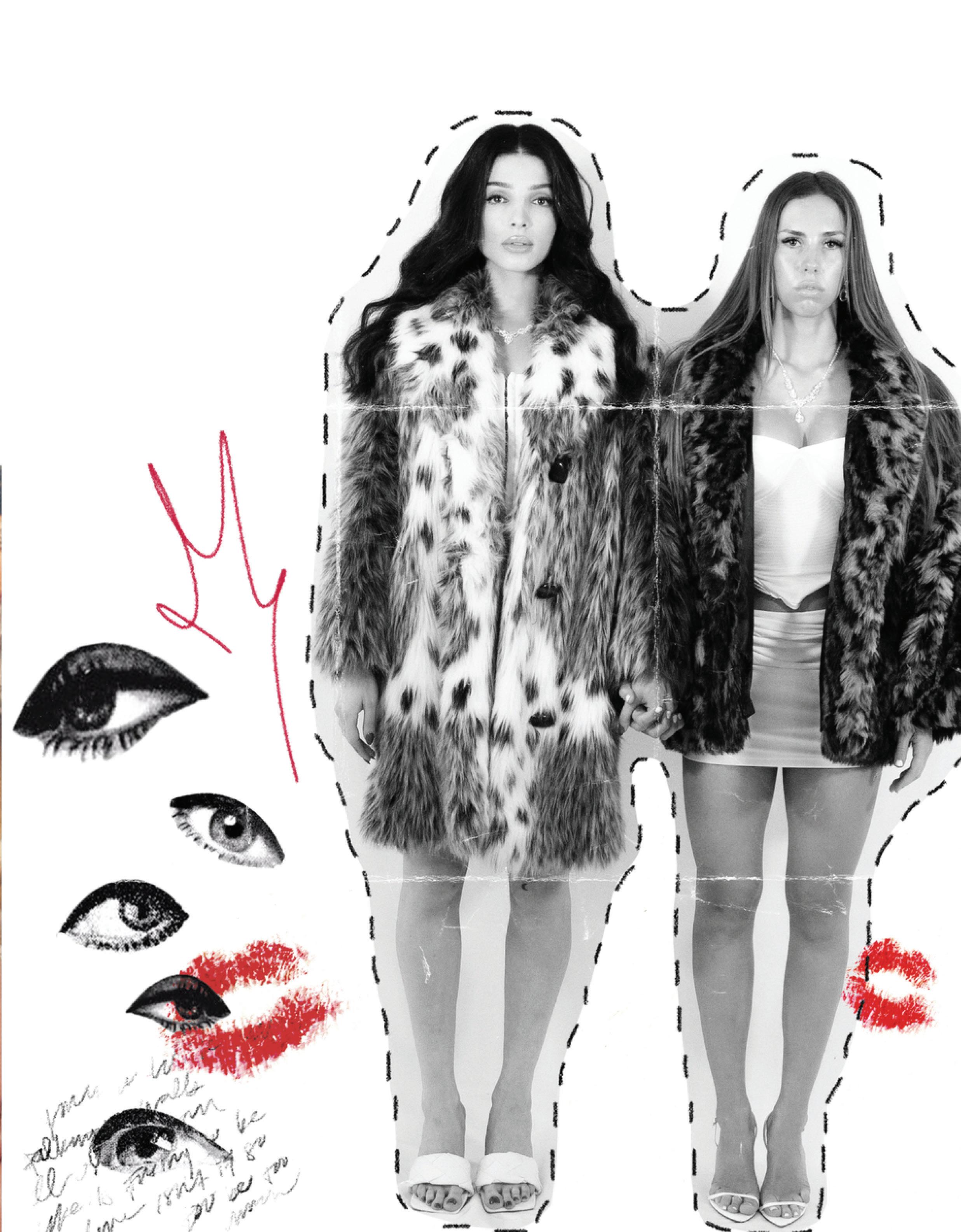
 By Tasha Karam
By Tasha Karam
She took off her glasses, letting in a world that was much more saturated and smothered with sunlight than when covered by tinted Chanel’s. Standing on a street lined with palm trees, dripping in designer, and leading towards the fairytale houses we dreamt about living in as kids, she was in Beverly Hills; a place known for housing Los Angeles’ most loved cosmetic enhancement and plastic surgery specialists. She was embarking down a path towards self-indulgement and achievement, marking the final milestones of her success.
Soon she’d be sitting in an office space, likely white, clean and minimalist, waiting to finally be freed from the ties connecting her to a past where she couldn’t self-govern her own body. This wasn’t for anyone other than herself. She had spent a lifetime navigating girlhood, overcoming self hatred, and finding ways to seek comfort in this beautiful, breathing vessel of hers. Now, her skin finally felt like her own.
Yet, as she sat waiting silently for her surgeon, this once quiet room filled with voices: “That bitch is botched.” “Ew she has fish lips.” “She’s only pretty cause daddy’s AMEX bought her a new face.” She silenced the voices by saying a prayer for the young girl whose bruises and scars still remained. The girl who spent ages 6-15 standing in front of her bathroom mirror before bed, only seeing flaws, never beauty. The girl who would dream about waking up one morning 20 lbs lighter, and who would spend annual birthday wishes hoping for a nose job. Today was for that girl.
People criticize those who undergo plastic surgery for a multitude of reasons. Some per-
ceive surgical appearance alterations as a sign of vanity or insecurity. Others may argue that society’s underlining on physical beauty and perfection creates unattainable standards, and that undergoing surgery to meet these standards perpetuates harmful beauty ideals. Or maybe some view plastic surgery as a superficial, temporary solution to deeper emotional and psychological issues. There is some truth that lies in these opinions. But in the same way that beauty cuts deeper than the surface, so does a person’s reasoning behind engaging in cosmetic enhancements and surgery. Regardless of one’s opinion, these procedures play pivotal roles in defining the autonomy that an individual holds over their own body.
As women, we are often told by others how to govern our own bodies. We live lives dictated by the male gaze, constantly criticized for our behavior, and perpetually judged on a scale of showing too much or too little skin. To be a woman is to feel the discomfort of being cat-called on the way to work. And to be told you can’t expect respect if you don’t have it for yourself. We’ve become accustomed to playing the game, becoming masters in the art of dealing with daily objectification and sexualization. It’s so easy for a woman to feel stripped of her rights to govern her own body, which is why cosmetic enhancements and plastic surgery are so valuable in allowing women to re-obtain their bodily autonomy. So, even though you might think Cardi B’s breast augmentation is too artificial, or that Chloe Cherry’s lips look botched, it’s a good thing they didn’t get them done for you.
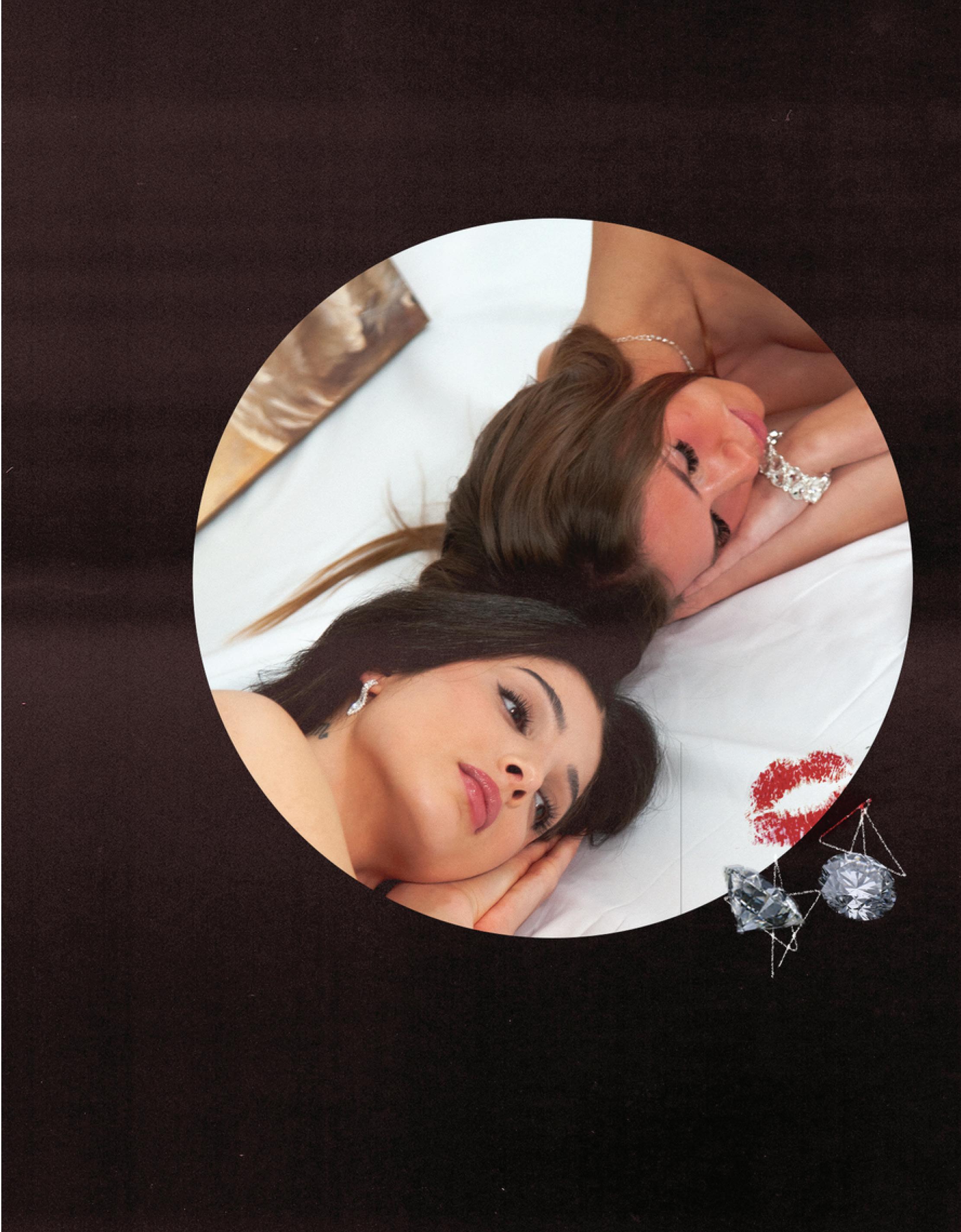
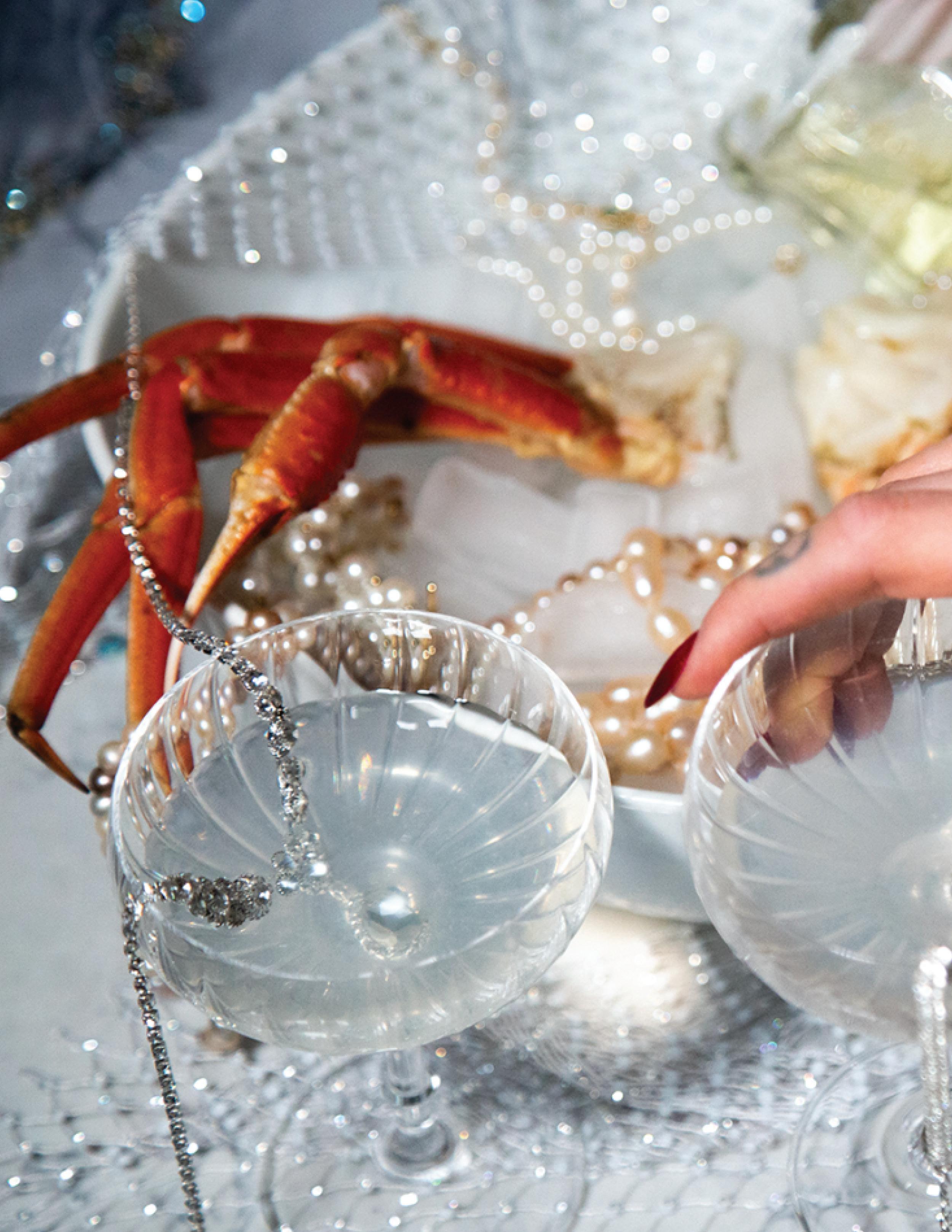

 Directors Ethan Cox, Lily Boses Design Gabby Pace, Nicole Han, Ethan Cox Photography Miranda Cardenas, Christian Zamora Beauty Gehna Chugani Videographer Natalie Lopez Production Christian Zamora Stylist Alexis Lee Models Isabella Silva, Natalie Lopez Writer Solia Mayo
Directors Ethan Cox, Lily Boses Design Gabby Pace, Nicole Han, Ethan Cox Photography Miranda Cardenas, Christian Zamora Beauty Gehna Chugani Videographer Natalie Lopez Production Christian Zamora Stylist Alexis Lee Models Isabella Silva, Natalie Lopez Writer Solia Mayo


Some Hispanic and Latinx owned small businesses in The Valley:
Flowers n’ Vases - Florist
21722 Devonshire St, Chatsworth, CA 91311
California Music Box - Music school
8990 Tampa Ave, Northridge, CA 91324
Laqué Nail Bar - Beauty salon
13041 Victory Blvd, Valley Glen, CA 91606
Porto’s Bakery and Café - Bakery
315 N Brand Blvd, Glendale, CA 91203

Manzanitas Los Originales - Candy store
120 N Maclay Ave, San Fernando, CA 91340
Mate Conmigo - Café 19257 Roscoe Blvd, Northridge, CA 91324
Let’s Talk Nails - Nail salon 14512 Haynes St, Van Nuys, CA 91411
Chula Chic Leather & Accessories - Clothing store
127 N Maclay Ave, San Fernando, CA 91340
Horchateria Rio Luna - Dessert shop 15950 Paramount Blvd,
Paramount, CA 90723
The Secret House of Ivy - Event venue 8140 2nd St, Downey, CA 90241
Healing and Growth - Marriage & Family Therapy / Mental health service
330 N Maclay Ave Suite 206, San Fernando, CA 91340
Out with the old, in with the new.
“Where I lived it was always new new new,” said Sienna Ribeiro, an LMU student and LA native, “but then I’d say 15 minutes outside of Sherman Oaks everything was at a standstill and that was where the poorer communities lived.” Only some parts of The Valley have experienced an upgrade, and in turn have drawn the most attention. These parts fulfill only half of the vision to become what everyone imagines LA to be. The other half would rather be left untouched.
The San Fernando Valley of Los Angeles occupies over 260 square miles, ranging North to South from Calabasas to Glendale and East to West from Granada Hills to Sherman Oaks. Angelenos who know it as “The Valley” also know that this part of Los Angeles is a melting pot of culture and class. It is home to both ethnic mobility and pockets of deep-seated poverty. The history of its inhabitants began with two indigenous people, the Tongva and Chuman, whose legacy was wiped out by decades of colonization and immigration. After California’s official statehood in 1850, The Valley became a high demand destination for European American homesteaders. Early segregation acts, followed by 1880s railroads, decided which neighborhoods could and could not accept people of color. To this day, generations of non-white valley inhabitants are impacted by discriminatory orders.
Through its current borderlines, one can see the clear divides of race and income. Many of the predominantly white areas coincide with a higher household income rate and have been subject to gentrification and renovation plans. Gehna Chugani of Strike Magazine LA recalls growing up while “Sherman Oaks was getting better over time.” She explains how her experience living in this bubble of The Valley is not reflective of San Fernando as a whole.
As I interviewed residents of The Valley, I noticed a theme of inconsistency. Locals of higher-class areas such as Sherman Oaks and Calabasas had a hard time abbreviating their upbringing because of endless environmental changes. Small family hole-in-the-wall’s that they remember from childhood were replaced by newer, fine dining restaurants. Authentic and affordable clothing shops were out of business and upgrad-
ed to trendy boutiques. Their descriptions of what The Valley looked like 10 years ago were erased by capitalist LA, and it is clear that these improvements were also selective.
Changes that benefit residents in higher income communities of The Valley are accepted, while those that don’t, such as low-income housing projects are protested. Members of the Sherman Oaks community have shown frustration towards recent proposals for a seven-story, 200-unit affordable housing plan. Protestors refuse to let their well maintained “family-friendly” atmosphere on Ethel Avenue sit adjacent to such a thing. What they don’t realize is that ignorance can only be bliss for so long, especially when every expectation of a blissful Los Angeles is upheld by isolating “the problem” - those tied to the roots of The real Valley.
Entertainment industry folks have found comfort in The Valley as it is removed enough from the buzz of Hollywood and Beverly Hills, yet close to the bigname studios like Universal and Warner Bros. Many notable celebrities have made their way to Calabasas and Hidden Hills including the Kardashians, Justin Bieber, and Drake. The recent development of bigger homes, gated communities, and luxury amenities have made private lifestyles the go-to over paparazzi filled streets. With median home prices that soar over $8M, these high-class neighborhoods exacerbate the already prominent wealth gap.
Lack of acknowledgment for the people who came before is what makes rich newcomers harmful. When people hear the area code 818, they likely think of Kendall Jenner’s tequila brand and nothing else. Such an appropriated identity which highlights only the side of its progression, has become the infamous and inaccurate depiction of The Valley.
So how do we define The real Valley when one side promotes celebrity tequila and the other goes out of business? We must share the spotlight and promote community support so we can help celebrate the roots of culture.
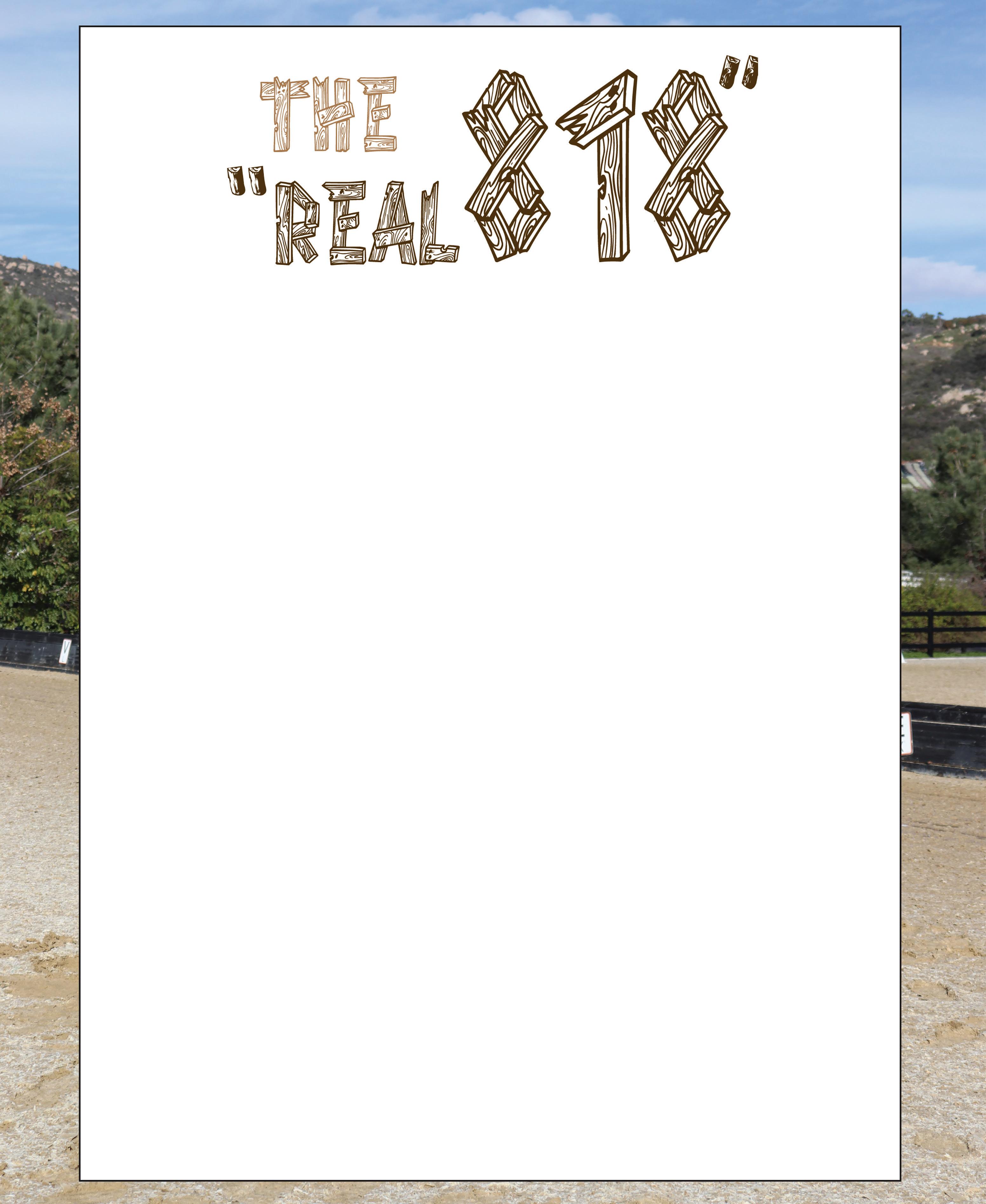 Written by Solia Mayo
Written by Solia Mayo
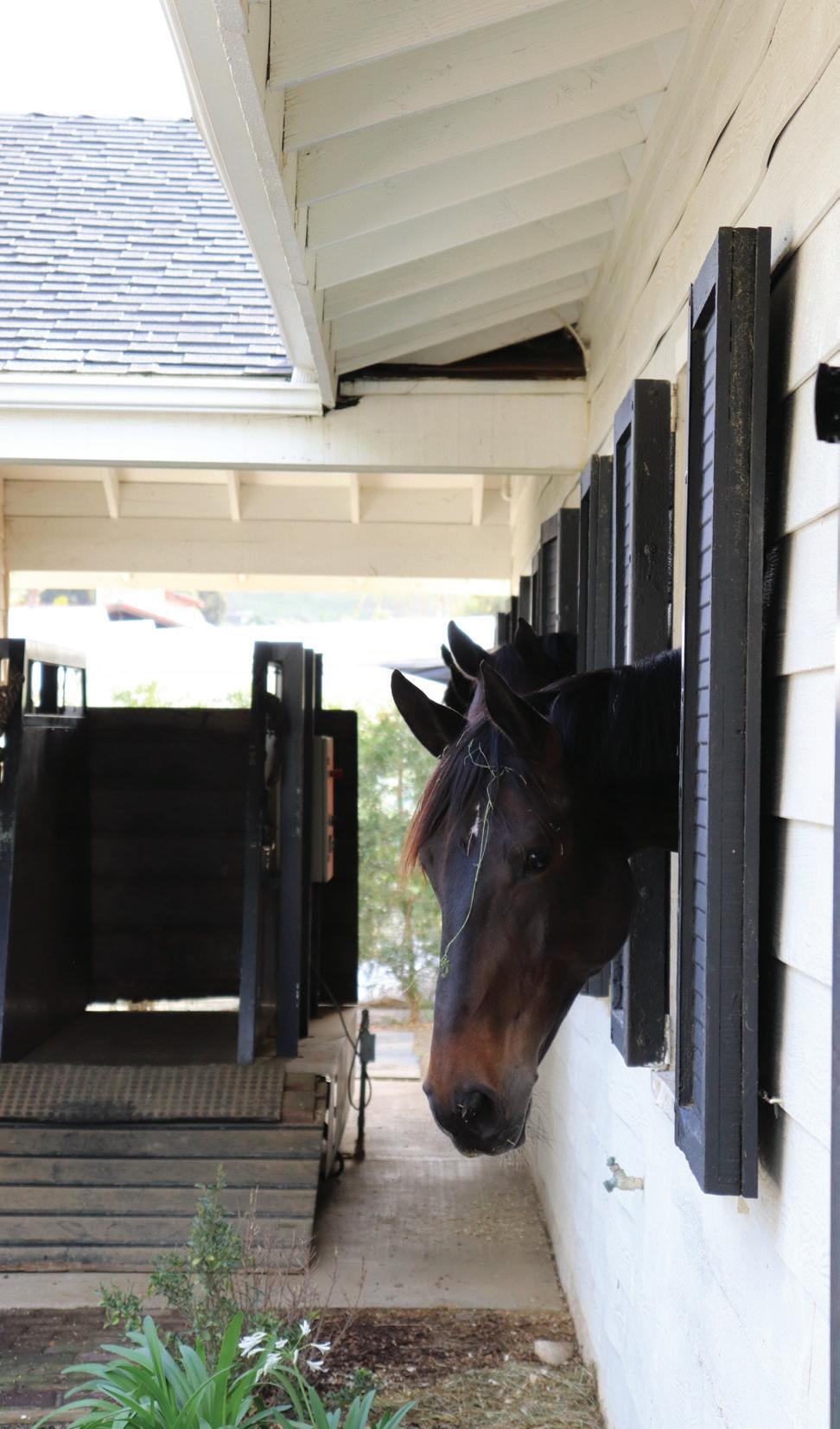

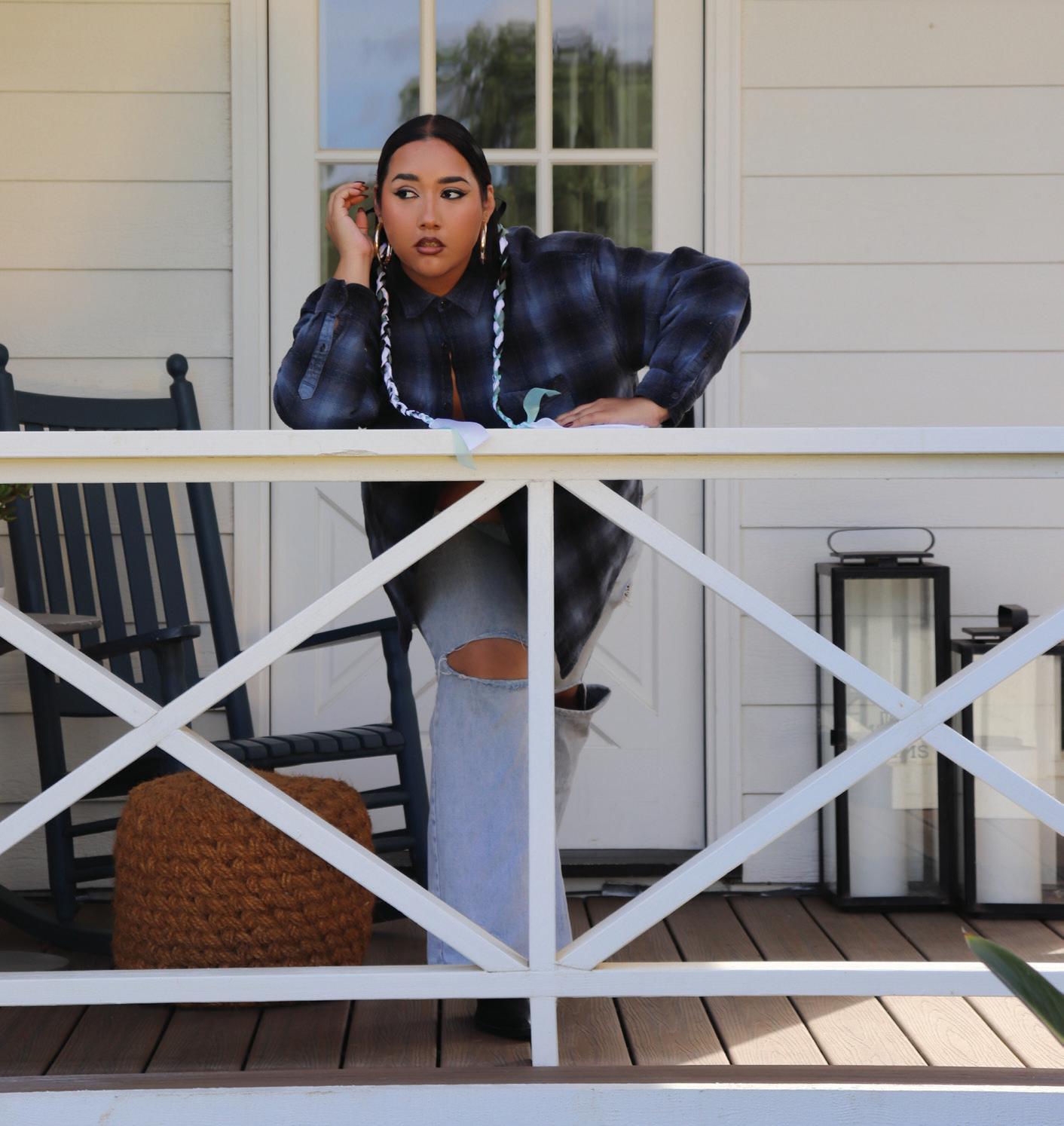




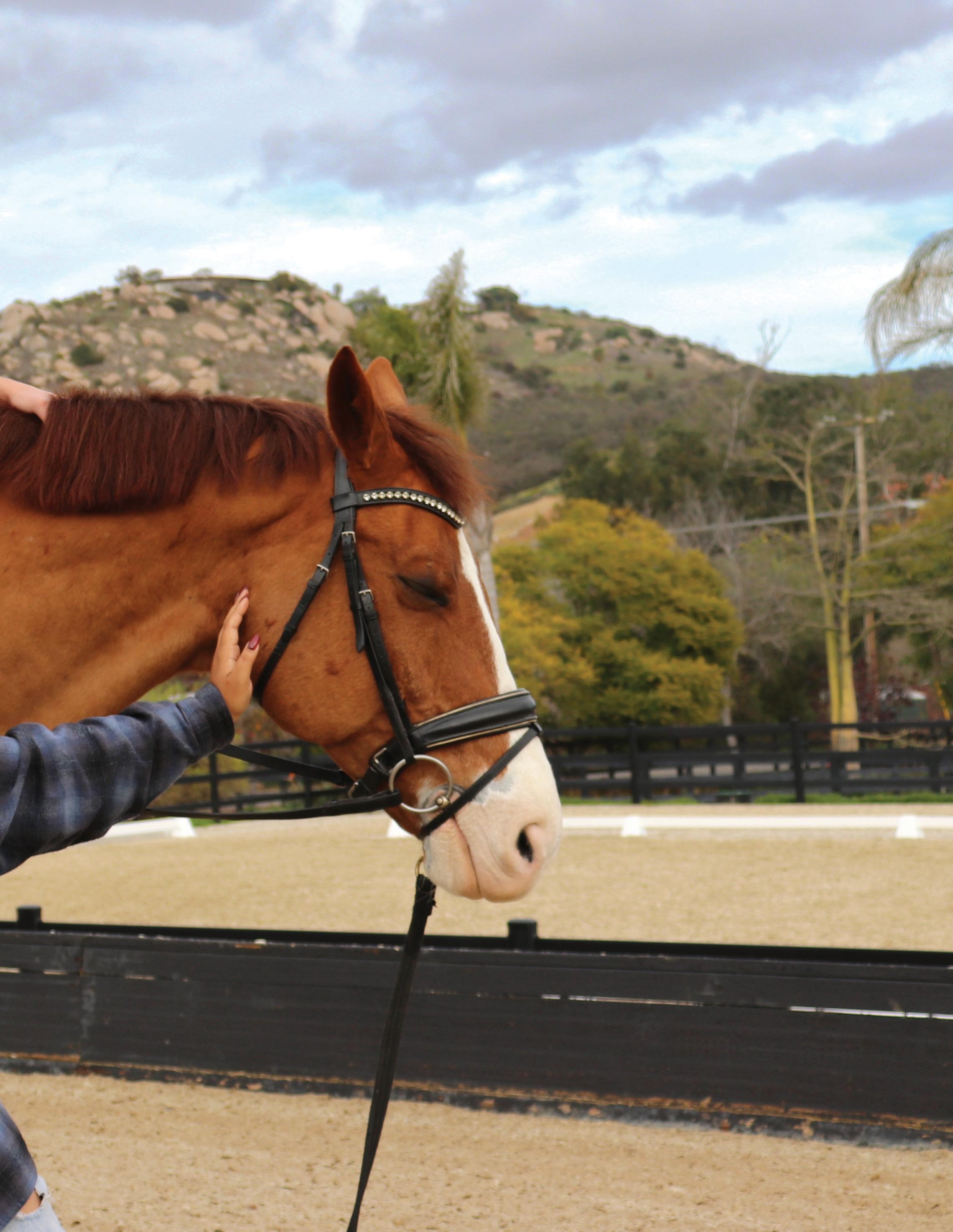

Directors Ethan Cox, Lily Boses Design Gabby Pace, Lily Boses, Ethan Cox Photography Miranda Cardenas Videographer Natalie Lopez Production Christian Zamora, Kira Shaw Stylist Alexis Lee, Ahu Alembegui Models Gabby Santangelo Writer Kate Graham


“Hollywood is a place where they’ll pay you a thousand dollars for a kiss and fifty cents for your soul.” - Marilyn Monroe
Welcome to Hollywood, where lips fetch fortunes, and souls are sold for mere pocket change. Littered with landmarks and crawling with creatives, Hollywood has become an exhibition of fame, fortune and fantasy that attracts fifty million tourists each and every year. While the streets are chock-full of production studios, the hills are home to an assortment of A list celebrities. Visitors flock like sheep, gallivanting down Hollywood Boulevard and snapping a series of shots at the Hollywood sign. Individuals from every corner of the globe are pulled to this place of mystery and elusiveness; a place where souls are sold, and devilish deals are made.
Though the cultural motif of ‘making a deal with the devil’ has become synonymous with Hollywood, its genesis dates back centuries. Originating within German folklore as the legend of the Faustian Bargain, the tale tells the story of Faust, a zealous scholar who seeks supreme knowledge and worldly pleasures. Tempted by the devil’s proposition of insurmountable wisdom and wealth, Faust makes a pact with the devil to surrender his soul. The tale has survived centuries, inspiring several religions, cultures and works of literature to reiterate its message on the dangers of ambitious greed.
Much like its iconic sign, Hollywood is a destination never intended for the masses to reach, but rather an attraction to be looked up at in admiration and awe; a symbol of aspiration rather than attainability. Its exclusivity leaves many desperate for answers and explanations behind such unattainable wealth and lifestyle. The internet has become a breeding ground for the discussion of theories of occult practices and demonic influences in Hollywood. Perpetuated in the media, in popular movies and in hit music, the entertainment industry, rather than make any sort of attempt to dispel it,
has openly embraced such theories, building it within its brand even. But while many label Hollywood the epicenter of drugs and demonic energy, such debauchery can be found in every direction we look.
Perhaps what these high profile figures do sell is their self-preservation. As careers in Hollywood crash and burn, the downward spirals and tragic endings speak to the gravity of stardom. From Marilyn Monroe to Amanda Bynes, such fate transcends decades. Exploited and commercialized, many celebrities are turned into puppets by mortal elites who pull the strings. Although celebrities enjoy the luxury of our worship and our wallets, their fame often carries a cost that not even wealth can buy.
Faust indulges in worldly pleasures, but his own greed catches up to him when his fantasy is cut short by his inevitable damnation. The fixation on Hollywood as the industry of selling your soul is attributable to its public presence, but truth be told, the Faustian bargain lives among all of us. While Hollywood is a perfect prescription for a much needed escape, it risks the possible side effects of insatiability and moral decay within society.
Regardless, Hollywood’s films and familiar faces have brought love, laughter, and light into millions of households throughout the past several decades. Its creativity brings individuals together, challenging norms, educating the masses, and offering a temporary oasis. To nitpick the negatives of Hollywood would diminish decades of hardwork and innovation.
Maybe the success of Hollywood and celebrity culture is the act of the devil, or maybe it’s the devil in all of us; our insatiable hunger for more. The tale of Faust warns us of what may come when we bargain our virtues for vices. The question begs, would you sacrifice your soul for a taste of the limelight?
Written by Kate Graham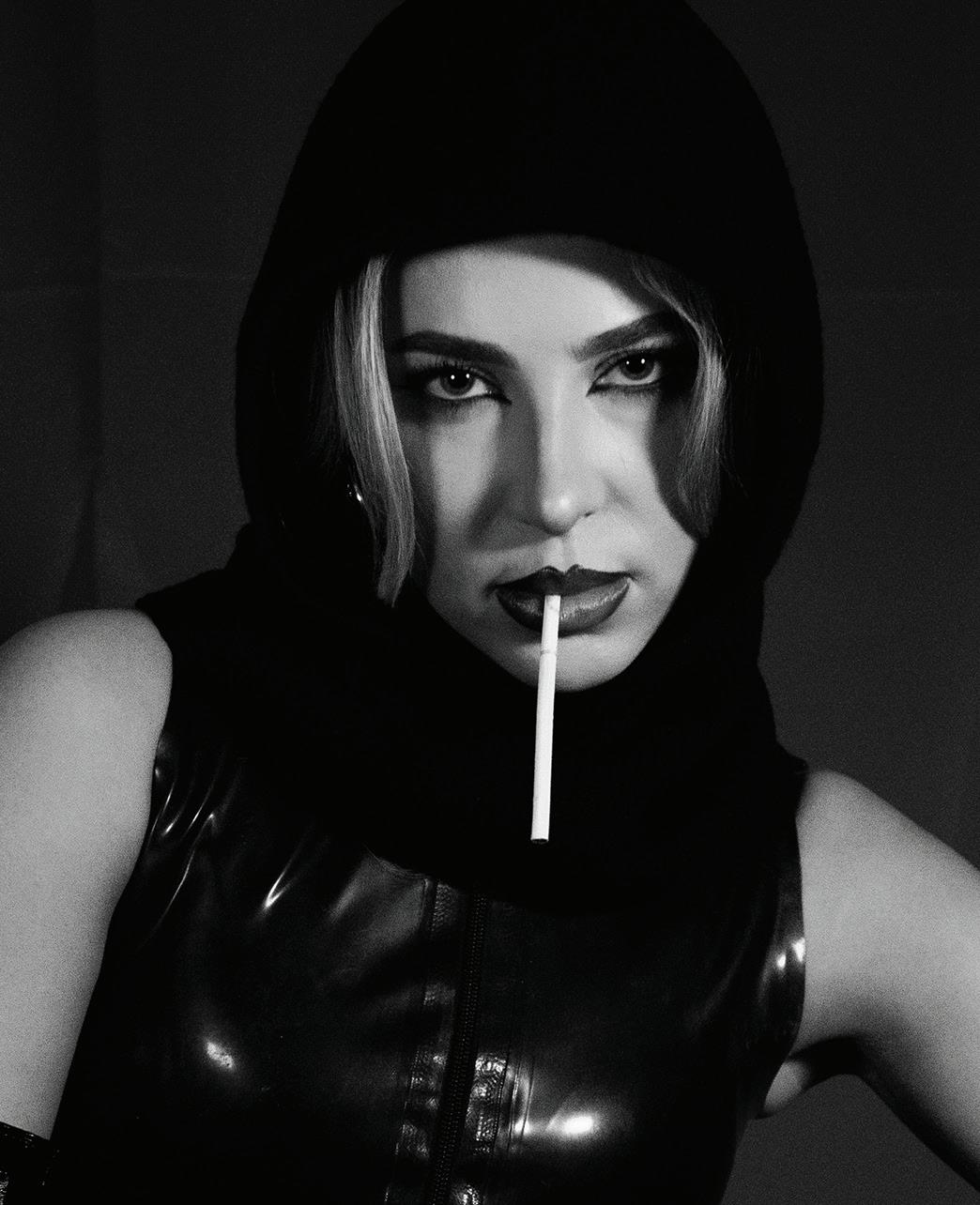
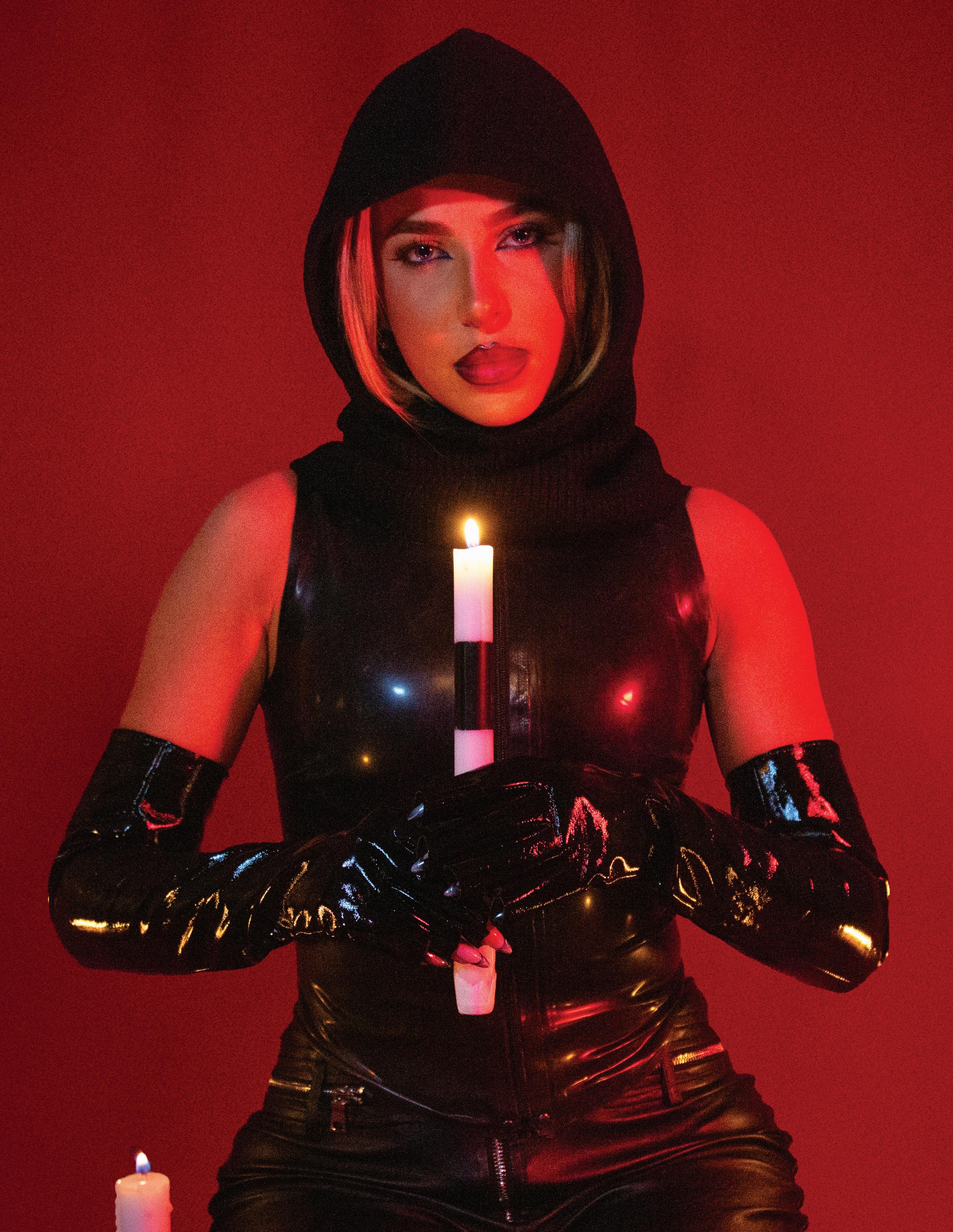


We were robbed of girlhood. Abandoning Barbies and play time in exchange for cheap vodka and parties in the hills. Trading tutus for mini skirts, Lollipops for cigarettes, Unadulterated innocence for tainted corruption.
Prized for our purity, Yet stripped of it by the age of 13. They looked past our age, And into the gaps between our barely fitting bombshell bras.
Eventually embracing the erotic, Driven by reputation and fancy cars, Hotel pools and table service, We’d start our pursuit for perfection. Embarking on a quest to seek validation. Drenched in suntan lotion, Counting calories, Daydreaming, And worshiping the Holy Trinity of sex, drugs, and boys.
We weren’t robbed of being girls because we wanted to be, We were robbed because we were submissive, Compliant to a lifestyle that dripped in glitz, glamor, and popularity when held from a distance. But up close, Not so much.
Up close, When not in a trance of delusion and denial, Or being fed cocktails of pills, alcohol, and lies, You could see the wrong, Feel the discomfort and sadness, Mourning the loss of a young girl who never got to truly be one.
A girl who lost her youth and girlhood to the hands of ‘The Bling Ring.’
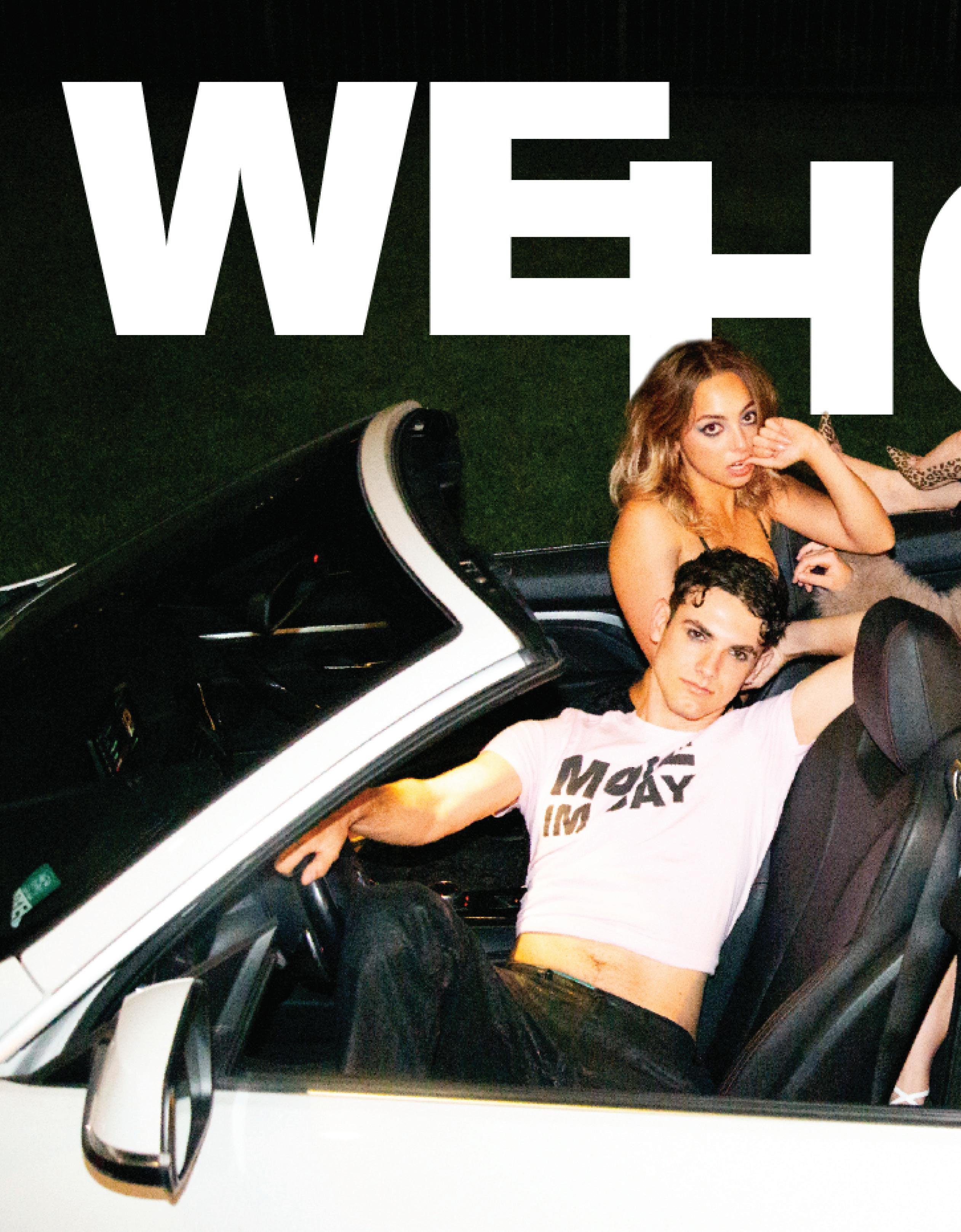
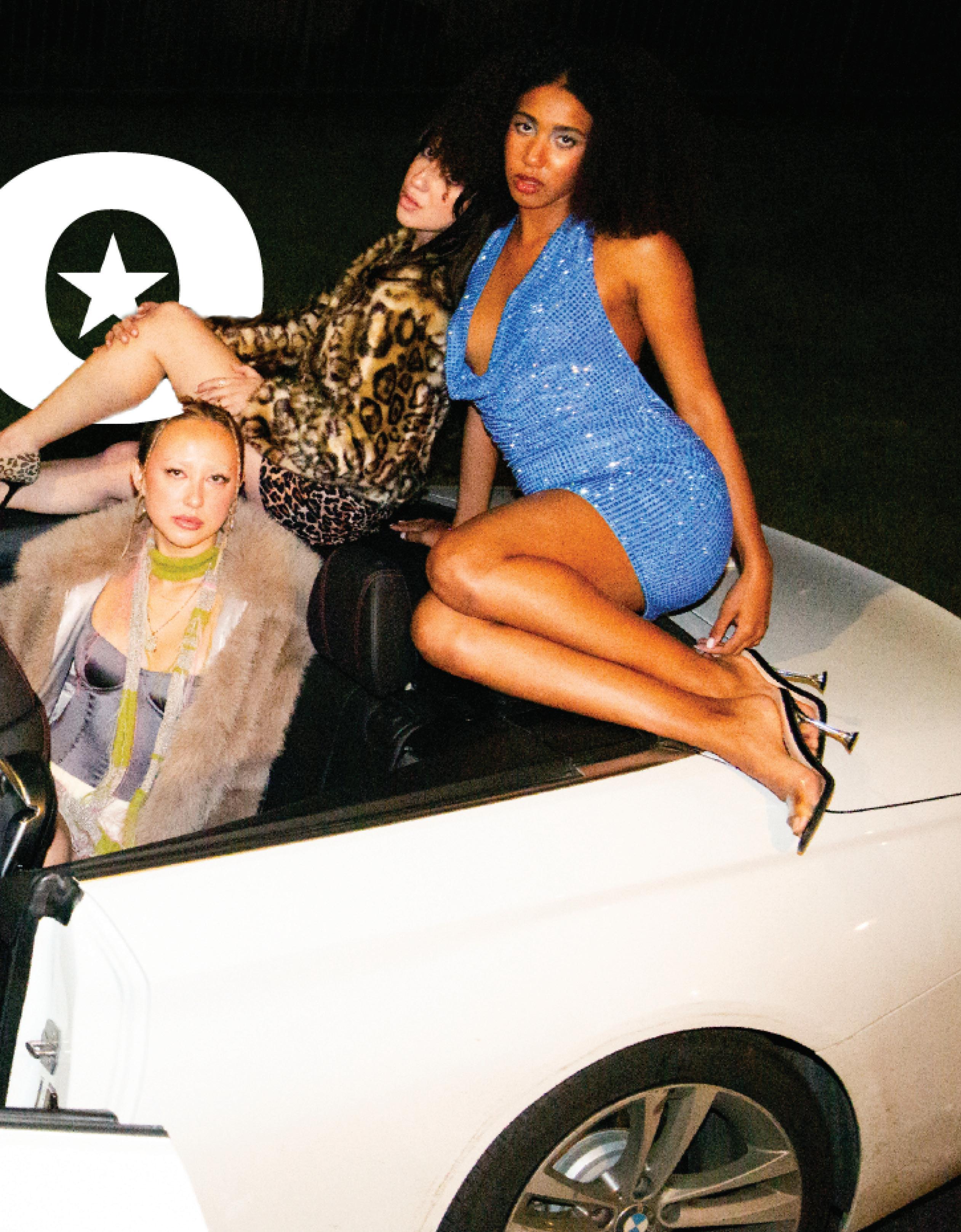
Directors Ethan Cox, Lily Boses Design Nicole Han
Photography Miranda Cardenas, Christian Zamora, Ethan Cox Beauty Gehna Chugani Videographer Natalie Lopez
Production Christian Zamora Stylist Alexis Lee Models
Will Soloman, Aurum Kashani, Olive Sun, Olivia Beeker, Lauren Goode, Victoria Batlle, Audrey Miner, Gabby Pace, Lily Boses Writer Leila Meftah


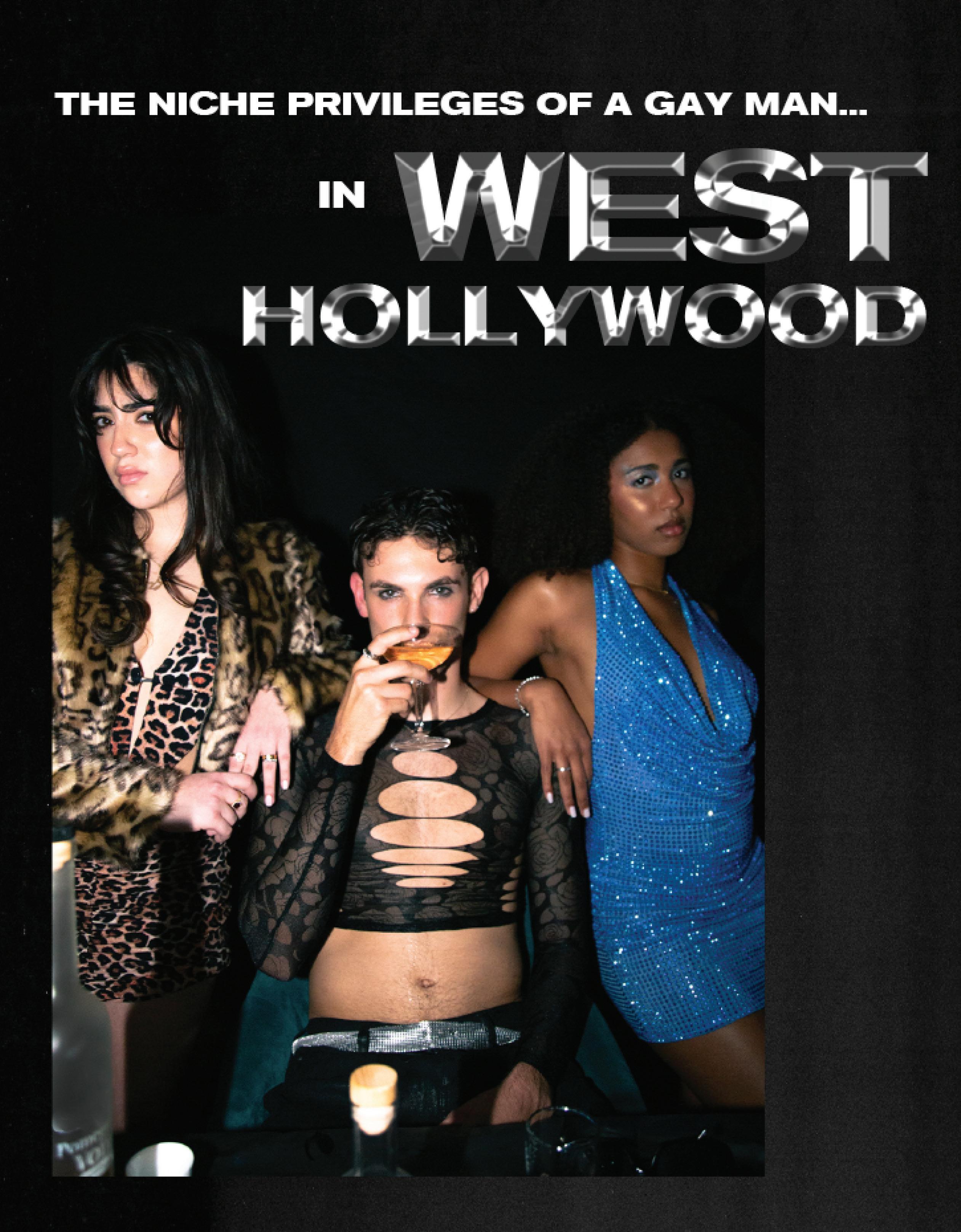
Everyone knows that men are at an extreme disadvantage when it comes to clubbing in LA.

Unless you’re spending hundreds, even thousands of dollars to buy a table, you should expect immediate rejection at the door. Home to Offsunset, Hyde, and Bootsy Bellows, some of LA’s best clubs reside in West Hollywood. Fortunately, not all men are out of luck. Gay men have found themselves in a particularly lucky position. The WeHo girls and gays have a somewhat transactional relationship. While the girls get to use their gay best friends as a way to repel men they don’t want to talk to, gay men are able to enter exclusive clubs without the burden of paying.
More notably, WeHo has a historically strong LGBTQ+ presence. Bars like The Abbey or Mother Lode offer a space for gay men to be amongst their own. Some of LA’s first gay bars were opened in WeHo between the late 1920s and early 1930s, and since then, WeHo has become a sanctuary for the gays of LA. However, the gay bars aren’t the only spots attracting those in the LGBTQ+ community. This is where the benefits of the dynamic duo between the gays and the girls really shine. Gay men aren’t just confined to specific bars, they’re privileged in that sense. Maybe outside of WeHo, gay men are still battling stigmas and ridicule, feeling trapped inside an outdated perspective on queerness, but inside the streets of WeHo, they stay on top.
In a world where gay men are largely excluded and marginalized, WeHo is a space for LGBTQ+ individuals to lean into their sexuality, owning it, and asserting dominance over heterosexual men. They are rarely extended privileges that are denied straight men, but WeHo defies all odds. Not only are gay men embraced by the clubs, but they’re embraced by the LA girls who are out looking for fellow club rats. There is something so special about the bond between an LA girly and her gay best friend, and WeHo is the strongest display of that beauty. Not only are there bars and spaces specifically allotted for queer folks, but gay men have found themselves able to get into some of WeHo’s most popular bars unsaved following behind the steps of their hot girlfriends.
However, in the busy world of West Hollywood’s nightlife, where beats and lights paint the town, the symbiotic relationship between LA’s “WeHo girls” and their gay counterparts is not just transactional; it’s a dance of liberation and camaraderie that defines the city’s illustrious scene. WeHo isn’t merely a destination; it’s an oasis.
The allure of WeHo’s LGBTQ+ haven lies not only in its acceptance of diverse sexual identities but also in the empowerment it grants gay men to unapologetically embrace their sexuality. In a society where exclusion and marginalization cast shadows, WeHo flips the script. It becomes a stage where gay men can revel in their unique brand of self-expression, asserting dominance over societal norms and heteronormative standards.
However, questions linger: does the preferential treatment at club doors extend beyond the realm of aesthetics and into the realm of identity politics? Could the seamless entry for gay men be a subtle commentary on societal perceptions of masculinity, where their presence is less likely to be regarded with the same scrutiny as their straight counterparts? Are bouncers reinforcing stereotypes by assuming that gay men always move in the company of attractive women, inadvertently elevating the club’s vibe? We must navigate WeHo’s nightlife with a discerning eye, unraveling the layers of acceptance and peeling back the facade to unveil the nuanced dynamics at play.
There’s something special we can all take away from the dynamics between the girls and the gays in WeHo; everyone brings something to the table. When we limit ourselves or others to certain assigned places, we limit the possibilities of growth and understanding.
Written by Leila Meftah


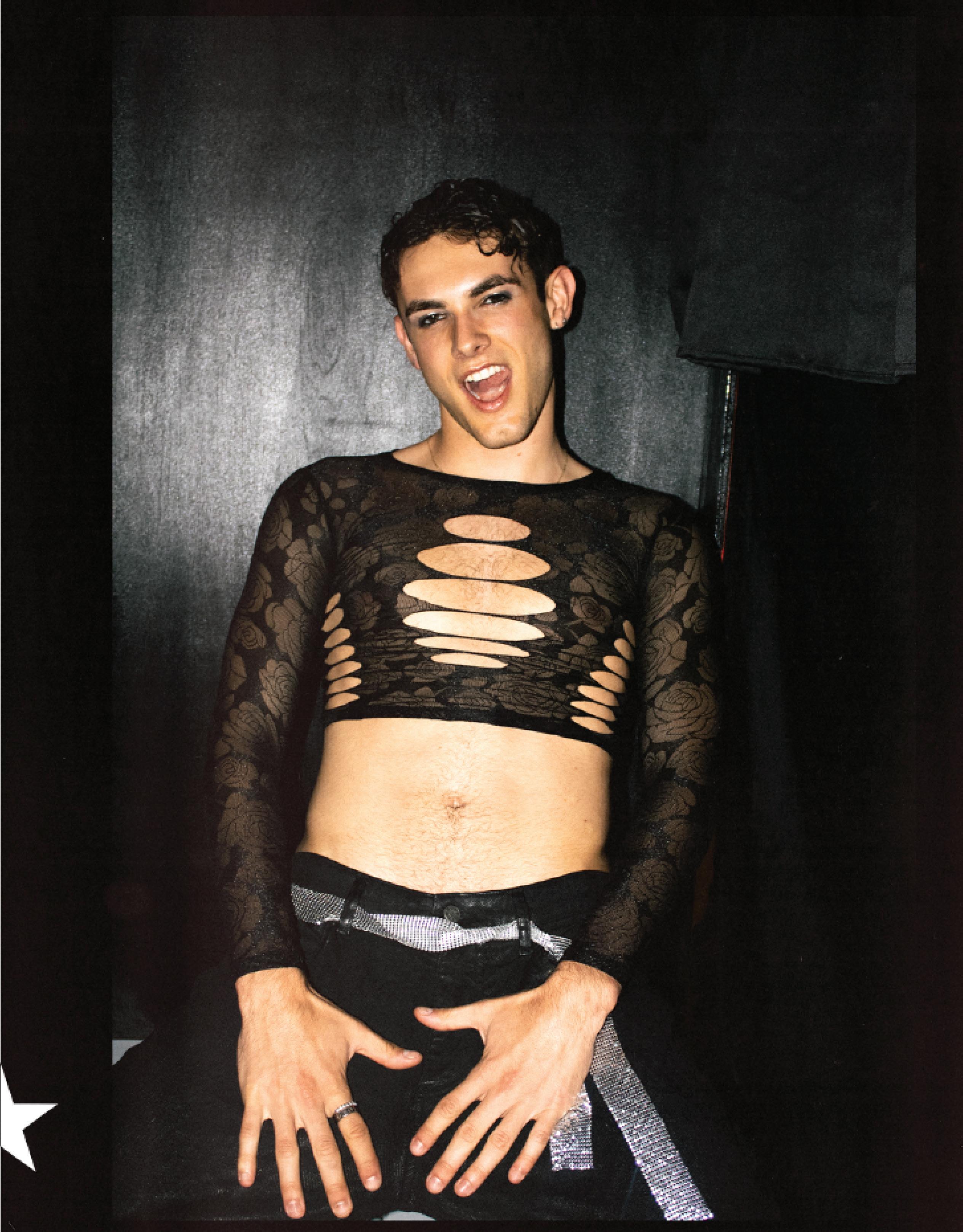



It’s all so sweet,
All that ever remains is the taste from the night before.
Something that tastes so sweet
But turns sour as the sun rises.
A fleeting love that’s always out of reach.
Never close enough to touch, Feel, Embrace, Explore.
A type of love only brought to life by flashing lights and too much tequila, And put to rest by regret, sobriety, and fear.
A grave that’s already dug itself before its life started.

Directors Ethan Cox, Lily Boses Design Lily Boses Photography Miranda Cardenas, Natalie Lopez, Ethan Cox Beauty Gehna Chugani Videographer Natalie Lopez Stylist Alexis Lee Models Mya Wojtasiak Writer Tova Golland, Tasha Karam
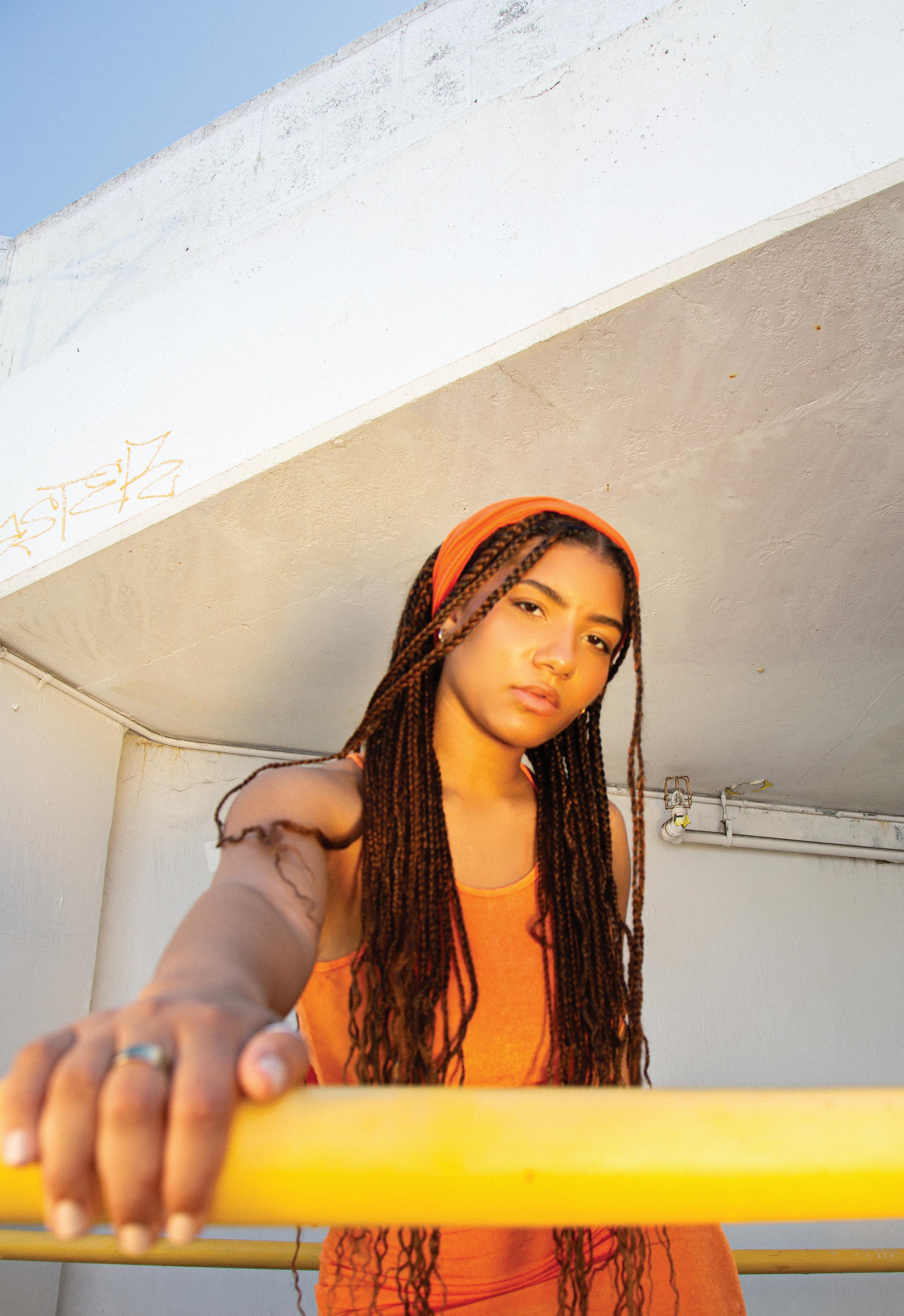

“Everyone in L.A. is fake” is a classic stereotype for people living in Los Angeles. This idea usually stems from social media; a place where people showcase their lives from the most glamorous perspective. But does living in Los Angeles automatically make someone fake? To answer this we’d need to start with the basics. Los Angeles is a city. And what makes a city? The people in it. Los Angeles, like any city, is full of people from a variety of ethnicities and socio-economic backgrounds. Many people come to Los Angeles to explore their opportunities in the hopes of accomplishing their dreams, whatever that dream may be. Yes, social media has caused people’s perspective of those who live in Los Angeles to become drastically negative over the years. However, it’s not seemingly fair to group an entire population of a city into one category: “fake”. The social media perspective of someone who lives in Los Angeles is not an entirely accurate depiction of the L.A. local. Social media has caused people to believe that Los Angeles is all about plastic surgery, social climbers, and spending money. But it has yet to shed light on the most unique aspect of L.A.: the diversity. If you happen to locate yourself in Los Angeles at any point, you’d be able to explore tons of entirely different cultural communities that you wouldn’t get to experience just anywhere.
Downtown Los Angeles is a snippet of the city where one can explore art, theater, music, museums, and exuberating culture. Gallery Row is an arts and culture district that’s in the heart of DTLA with over 50 art galleries, museums, theaters, and public art installations. It’s a unique part of Los Angeles that people don’t talk about enough. There’s also the Arts District which is a neighborhood within DTLA that includes communities like Little Tokyo and Chinatown. There’s people and establishments there that have been around forever and showcase the amount of diversity and culture one can find within Los Angeles as well as dispute the stereotype that “everyone in L.A. is fake”.
People are so obsessed with labeling those who are located in L.A. as fake that they don’t realize that they’re the ones who are being short-minded and ‘fake’. To group an entire population of people into one word is unjust and untrue. Yes, there are some people in Los Angeles who might glamorize their life on social media, giving those perceiving it a false perception of reality, but the majority of people come to L.A. to pursue something. And that’s what L.A. is all about, the invitation to chase your own reality and achieve your goals.
Give the people what they want? Well, what they want is for 2024 to give the same L.A. atmosphere as 2016 did. A resurgence in Tumblr filters, casual instagram posting, and music from the 2016 period have all been resurfacing within the world of social media, and we are more than here for it. The 2016 cultural comeback may have revived itself when the world saw Kylie post a pic of herself with light bubblegum pink hair, reminding her fans of her ‘King Kylie era’. Later on, Kylie posted a TikTok to the song, 3 Strikes by Terror Jr, which featured Kylie as the star of the song’s music video. Anyone who lived through 2016 knew 3 Strikes as the ‘King Kylie’ song of 2016. The music video itself was a cultural reset . Kylie also posted a TikTok using the filter titled ‘2016’, giving users an ‘instagram filter’ look. Afterwards, people started to use this filter all over TikTok. This social media influence has also made its way through new music that’s making an appearance in 2024. Charli XCX, an iconic 2016 pop-star, just announced that she will be releasing her next album, BRAT , this summer.
But the 2016 vibes don’t stop with music. The mid 2010s fashion trends have also been weaving their way into 2024, but are slightly modified. Although likely to be a micro-trend this year, forms of chokers have made a comeback. We’ve seen this on influencers all over social media, except instead of the thick, velvet, black chokers, the girls are elevating the choker with a more simplistic approach. Dainty, silk-like chokers, some with a big flower on them, have become an accessory utilized to elevate an outfit. Another noticeable fashion-grab stemming from the 2016 era is the Adidas sneaker. In 2016, the AdidasSuperstars were worn by every teenager, everywhere. Some people stuck with the classic white with black stripes, others branched out and wore the white with metallic stripes. We see a similar thing happening in 2024 with Adidas Sambas. Although sambas made their resurgence in 2022, Sambas have become the most popular everyday shoe for a lot of people. But Adidas has collabed with companies like Wales Bonner and Gucci recently to create a vibrant and unique version of their Samba shoe and
people have been loving it. Just like in 2016, for some people, all they need in 2024 is the classic black and white samba shoe, but others venture out to vibrant colored, cheetah print, and even metallic ones.
It’s no doubt that 2016 was one of most culturally significant years for those of us who grew up in it, but how did we get the privilege to have it be revived in 2024?
With the world being so fast paced, trends and aesthetics are not only constantly evolving, but are also being pulled from different time periods with fashion trends from the past. We’ve seen it with aspects of the 90s and early 2000s with low-rise jeans and thin, Pamela Anderson eyebrows making a comeback. Now we are seeing trends from 2016 weaving their way into what we as society deem as ‘in’ or trendy. It’s almost as if we look for this sense of unadulterated nostalgia from the past to fulfill what’s missing in our lives today, especially given that 2016 was a time period where a lot of us experienced our teenage years. A significant decade where we are figuring out how to balance responsibility with the craving for freedom. Instagram filters, The Chain Smokers, LF, Brandy Melville, and Kylie Lip Kits were all outlets to help us obtain our teenage freedom. So give the people what they want? Well, maybe the people want to wear chokers and be able to post more casually again on instagram. But the underlying truth is that people just want to feel as free as they did in 2016, and who could blame them?

